Product Categories
SHOP BY ARTIST
NEWSLETTER
Products
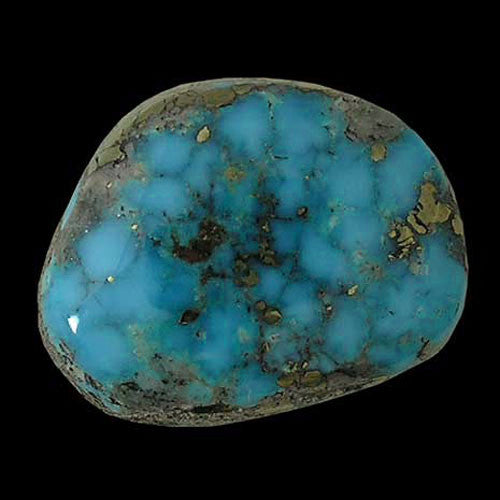
11.21 cts Natural Gem Grade Morenci Turquoise Cabochon (#15)
$224.00$300.00
Natural Morenci Turquoise
11.21 cts.
1/2" tall x 5/8" wide
We offer a 100% satisfaction guarantee on every purchase.
Morenci Turquoise; Arizona Mine, Morenci, Clifton-Morenci District, Shannon Mountains, Greenlee County, Arizona, USA. An open pit copper mine located in the N1⁄2 Section 16, T4S, R29E (Clifton 15 minute topographic map), owned by Phelps Dodge Corp. Map Reference: 33°5'26"N , 109°21'58"W.
Morenci turquoise was mined in southeastern Arizona until approximately 1990. It is located very near the New Mexico border, and ranges in color from classic high electric blue to light azure. Prehistoric Indians who valued the stone for its deep blue color were the first to discover the deposit. These people adorned themselves with rough hewn beads and carved talisman made from the mineral
Morenci is often associated with an unusual black matrix of irregular iron pyrite, which looks metallic when polished. Although they are rare, stones with unusual birds-eye patterns, red matrix and an occasional layer of silver have also been found. The Morenci name is derived from the large open pit copper mine owned and operated by the Phelps Dodge Corporation. Early examples of this striking turquoise were of the "lunch box" variety, meaning they were carried out of the mine by workers and miners.
Morenci is well known; it was one of the first types of American turquoise to find its way to the market and is always difficult to obtain because the mine was depleted so long ago. It is believed that the best Morenci ever produced was discovered in the late 1960's to early 70's. During this time period, the mine produced a high, electric blue variety with iron pyrite inclusions. Since Morenci is no longer being mined, and because of its striking color and unusual matrix combinations, high grade natural Morenci is a valuable, highly collectible mineral.
USGS; Arizona.--In Arizona turquoise ranks first in terms of value of production and is also the best known of its gem materials. Nearly all important deposits of turquoise are located near copper occurrences or in copper deposits in arid desert regions of the world. Thus, the world famous turquoise deposits associated with certain of the large Arizona copper deposits are to be expected.
Turquoise is, or has been, mined from a number of these copper mines as a byproduct, usually by outside contractors. The financial and operating terms of the collecting contracts vary from mine to mine. Some of the operations are little more than the efforts of individual commercial collectors; some are essentially full-scale mining operations that are simultaneous with, but separate from, the regular mining operations; and still others operate on an on-call basis as turquoise is uncovered by the regular copper mining operation. Regardless of the size or sophistication of the initial mining or recovery operation, the actual turquoise is recovered by careful extraction using hand methods.
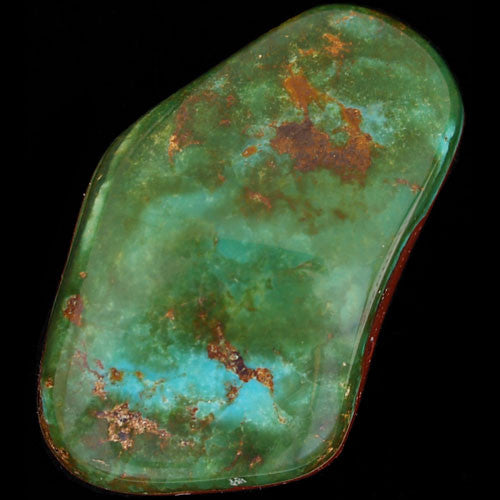
110 ct Blue Gem Turquoise Cabachon (#13)
$2,750.00
Natural Turquoise Cabachons
2" x 1 1/4"
This is a monster piece of super high-grade natural Blue Gem turquoise. The Blue Gem mine near Battle Mountain, Nevada was long ago pulverized and processed for copper and other precious metals, so turquoise from this location is no longer available. This extremely hard stone was cut and polished by the DePriest family of Manassa, Colorado in the 1970s. We bought a collection from Gary DePriest in the 90s and finally decided it needs a new home. This baby has waited far too long to have its natural beauty and unique character exposed.
We offer a 100% satisfaction guarantee on every purchase.
Blue Gem Turquoise
Blue Gem turquoise occurs in argillized quartz monzonite cut by two limonite-stained sheer zones, one trending N 35 o W and dipping 75 o NE, the other trending N, 25 o E and dipping 55 o NW. An extensive breccia zone about 10 feet wide is developed between the two bounding sheers. Exceptionally good quality turquoise forms veins up to three-quarters of an inch thick along the shears. Pyrite-bearing quartz veins are closely associated with the turquoise.
The Blue Gem mine was at one time located deep underground, accessed by tunnels as deep as 800 feet. This is of interest because the Blue Gem Mine and the Bisbee Mine in Arizona are the only two mines (of which we are aware) that turquoise was found that deep in the earth. The Blue Gem mine was once developed in extensive underground workings and open stoops. An audit several hundred feet long on the main structure connected to numerous shorter tunnels and several open stoops. Directly above the main audit was a glory hole some 100 feet long.
Duke Goff first noted the Blue Gem deposit in 1934. It was subsequently leased from the Copper Canyon Mining Co. by the American Gem Co. of San Gabriel, CA., owned by Doc Wilson and his sons, Del and William. The company operated the property until 1941 when the outbreak of the war caused a shortage of experienced miners. Both Del and William Wilson were called into the Army for the duration of the war, and this compelled the closing of the mine. Consequently, the lease was allowed to lapse and work was abandoned. In 1950 Lee Hand and Alvin Layton of Battle Mountain leased the mine.
Production of turquoise at the Blue Gem lease in the early days of the operation was enormous. Although there is no exact information, it is reported that the output amounted to nearly
$1 million in rough turquoise. The mine is still active, although Duval Corp is currently in the center of a major copper deposit developing it.
Pyrite in Blue Gem is unusual to see but not unheard of. Very little large material ever came out of Blue Gem, the majority found was small 1-mm "bleeder" veins and tiny nuggets which was perfect for Zuni inlay and fine needlepoint, petit-point and snake-eyes jewelry. Blue Gem turquoise was very popular in the late 1930's and 40's and was commonly used in the Fred Harvey "tourist jewelry" that is so collectable today. Blue Gem turquoise is extremely hard and stands up well to the test of time.
Blue Gem turquoise is a rare, valuable and historic American treasure. Quality Blue Gem Turquoise has been gifted with a wide range and variety of color. Because Blue Gem turquoise is very hard, a high polish is associated with this stone, and unlike most turquoise, won't easily change color. This turquoise has a unique character and many different looks all of which are striking, full of wonder and pleasing to the eye.
Production of the mine started about 1934 and continued into the 1970's. Blue Gem Turquoise is still some of the finest turquoise ever found, and unlike most turquoise mines, (in which the majority mined is chalky and only usable if stabilized) most of the turquoise found there was of gem-quality. Today the Blue Gem mine is not viable; it sits in the middle of a huge mining operation. The emphasis is on precious metals and the extraction of turquoise is considered more of a hindrance in the mining process rather than an asset. Even the ever-popular "Dump Diving" for turquoise through the overburden is not tolerated due to the very real danger of becoming buried in a slide. Insurance factors, equipment hazards, high explosives and safety issues along with a lack of interest from the mining company keep Blue Gem turquoise unavailable to the world, at least for now.
Related legends:
Precious Stones
Turquoise; Precious stones have symbolic implications. For example, turquoise if a "collective term for all the precious stones, wealth, or mixed offerings. Good fortune is attributed to this stone." Both white shell and turquoise are emphasized in Kinaalda? More about this legend
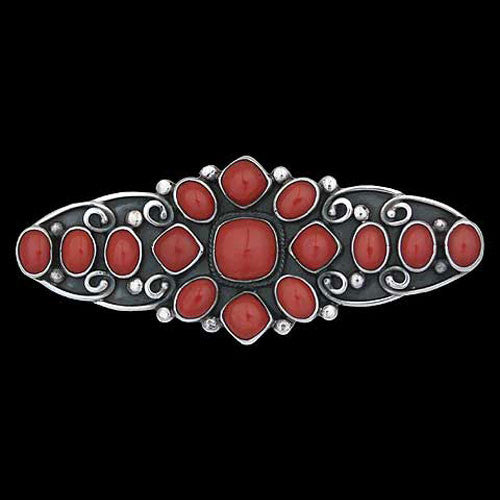
15 Stone Navajo Coral Brooch - Verdy Jake (#30)
$450.00
Artist: Verdy Jake
Navajo Jewelry
Handmade Sterling Silver Brooch set with 15 Natural Coral Stones
2 3/4" wide x 1" tall
Largest Stone - 3/8" tall x 3/8" wide
We offer a 100% satisfaction guarantee on every purchase.
Coral was introduced to Native peoples of the American southwest in the 1400's by Spanish explorers. Its instant and enduring popularity is attributed to the vibrant range of color; from red to orange, pink and black. Due to its rarity and association with birth and existence, blood red is by far the most popular color. Verde Jake crafts jewelry reminiscent of that created in the early part of the twentieth century. Using basic tools passed down by her grandfather, Verde skillfully recreates heirloom quality wearable art from sterling silver and precious stones.
About the artist:
The jewelry created by Navajo silversmith Verdy Jake reflects Southwest jewelry classicism at its best. Showcasing high quality turquoise and coral with substantial silver work, she intuits a perfect balance between precious metal and precious stone.
Related legends:
Silversmith Work
When and how the Navajo acquired the art of working metals is unknown but there are reasons for supposing that it was introduced among them, or at least more developed and improved upon by them, since the time they have occupied their present country?
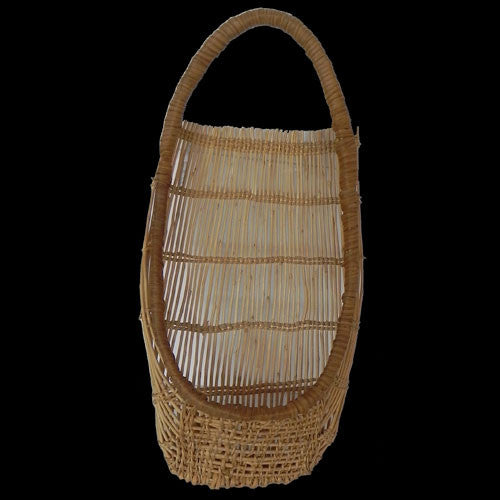
1920's Hupa Doll Size Baby Carrier (#06)
$395.00
Folk Art
6" x 12 1/2"
During the 1980's and 1990's Georgiana was traveling the back-roads of California and Nevada, buying, selling, trading and collecting. This fine little Hupa baby carrier was one of her acquisitions. Made in the 1920's with hazel branches and conifer wrapping, it would have been the envy of every Hupa mother in training.
We offer a 100% satisfaction guarantee on every purchase.
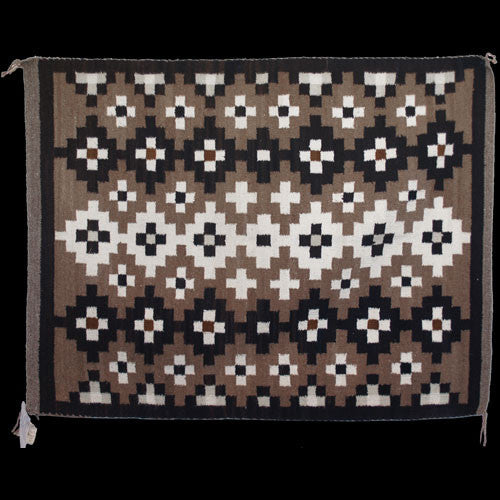
1930's Navajo Duality Symbol Rug (#54)
$800.00
There is something warm, fuzzy and wonderful about an old, hand-woven, Navajo rug. To know that some hard-working individual sheared the sheep, cleaned, carded and spun the wool is amazing because the job is so labor intensive. This particular textile has some age on it. It was woven sometime in the 1930's and then put away. There is absolutely no wear on this rug. It’s in pristine condition. Duality crosses pertain directly to the basis of Navajo culture, which are Hozho, harmony and balance. Nothing could be more closely associated to Navajo tradition than this piece of art.
Related legends:
Symbolism
The hoop ceremonies of the Navajo have been compared by anthropologists to mandalas, Paleolithic sunwheels, or "magic circles." Spruce, willow, and other hoops represent the four passages of man through the four elemental worlds. They are also symbolic of the four directions, the four sacred mountains, the four-cornered construct of the human family mother, father, son, daughter and the four stages of human life? More about this legend
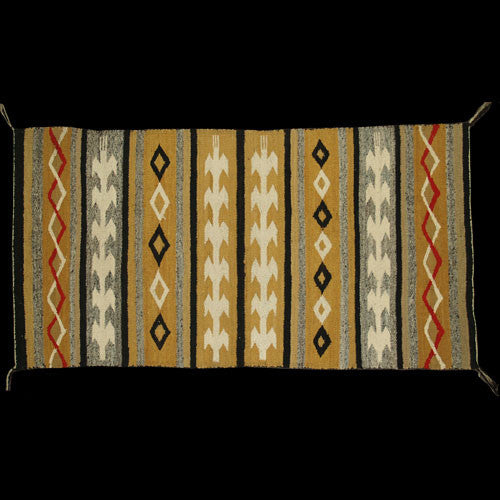
1950's Hand Spun Wool Naslini Corn Rug (#34)
$850.00
Navajo Rugs
59" x 38"
To the Navajo, corn is the fruit of life. Images of the corn plant stand as a metaphor for connections to the past, present and future along with perceptions of the upward moving way. This fun and fluffy, 1960's era textile comes to us through a Nevada estate sale. It is completely hand spun and is accented with vegetable dyes. Navajo rugs don't get any earthier or homegrown than this.
We offer a 100% satisfaction guarantee on every purchase.
Related legends:
Weaving
After the medicine woman told the people about the prayersticks she told them that there was a place in the underworld where two rivers crossed. It was called ni tqin'kae tsosi, fine fiber cotton (Indian hemp). There were two persons who brought the seed of that plant, they were spiders. They said that the people were to use the plant instead of skins for their clothing. So this seed was planted in the earth? More about this legend
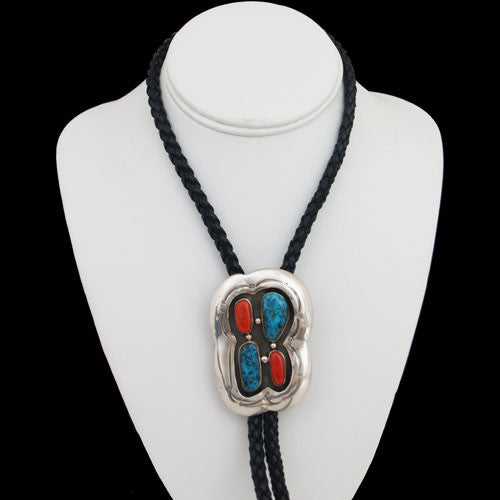
1960's Blue Diamond Turquoise and Coral Bolo Tie (#52)
$495.00
Bolo: 2" x 2 3/4"
Strap: 44" long
This antique bolo tie from the 1960s is fashioned with Blue Diamond turquoise and Mediterranean coral. Using a shadowbox style to showcase the first-rate stones, the unknown artist put together an interesting work that has stood the test of time.
Related legends:
Silversmith Work
When and how the Navajo acquired the art of working metals is unknown but there are reasons for supposing that it was introduced among them, or at least more developed and improved upon by them, since the time they have occupied their present country?
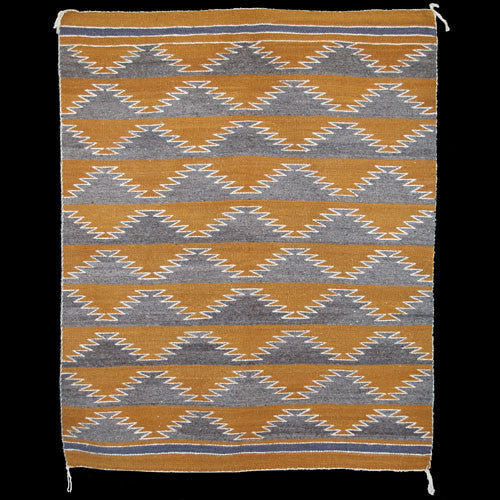
1960's Crystal Rug (#27)
$950.00
Navajo Rugs
49 1/2" x 40 1/2"
Hand-spun rugs are an anachronism. They are so labor intensive it is a wonder they are ever woven. And these days they are often not. This fine example was woven in the 1960s and features natural wool and plant dyes, nothing unnatural. The rug can be used on the floor or on the wall. It will be great anywhere.
We offer a 100% satisfaction guarantee on every purchase.
Related legends:
Crystals
First Man burned a crystal for a fire. The crystal belonged to the male and was the symbol of the mind and of clear seeing. When First Man burned it, it was the mind's awakening? More about this legend
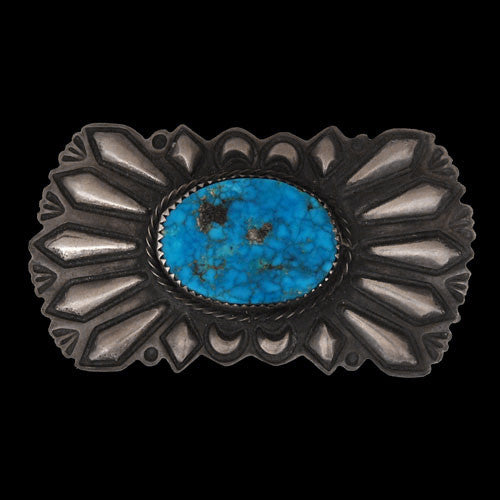
1970s Silver & Water Web Morenci Turquoise Pin (#42)
$420.00
Navajo Jewelry
1970s Handmade silver pin set with natural, Water Web Morenci turquoise
2 1/2" wide x 1 3/8" tall
14 carats of Morenci turquoise
Twin Rocks Private Reserve
This broach is what we call a "filler pin". Navajo women would wear a broach like this at the collar between the V strands of beads and turquoise of a squash blossom necklace. We collected this piece in the mid 1970's because it contains a stunning piece of high-grade, natural water-web Morenci turquoise. Steve and I have argued about whether or not to unset the stone and place it in something more "jewelry familiar" or leave it as it was first set. As you can see we are giving the piece a chance to grace someone's collection as it was initially crafted. This is a great piece of Navajo jewelry created to be worn by Native peoples.
We offer a 100% satisfaction guarantee on every purchase.
Related legends:
Silversmith Work
When and how the Navajo acquired the art of working metals is unknown but there are reasons for supposing that it was introduced among them, or at least more developed and improved upon by them, since the time they have occupied their present country?
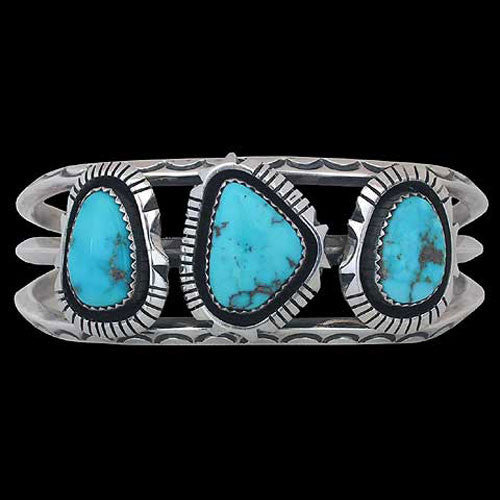
3 Stone Godber Turquoise Bracelet - Toby Henderson (#071)
$750.00
Artist: Toby Henderson
Navajo Jewelry
Hand Stamped Sterling Silver Bracelet
set with Natural Godber Turquoise
Size - 6 7/8
Inner Circumference - 5 5/8"
Opening - 1 1/4"
Center Stone - 3/4" tall x 1/2" wide
We offer a 100% satisfaction guarantee on every purchase.
About the artist:

Toby Henderson was born and raised in Phoenix, Arizona. The roots of his family tree are buried deep in the Borrego Pass area of the Navajo Reservation in New Mexico. Toby's mother Ella Long, his grandparents, Helen and Jim Long, and his Uncle Phillip Long, and Tommy Long are all silver and gold smiths recognized for high quality and innovative workmanship. Toby learned his art from his grandparents with whom he spent the summer months when he was a young boy. Toby recalls that his Grandparents were patient and inspiring instructors. They were pleased that he was carrying on the family silversmith tradition. Toby's work can be described as both traditional and contemporary, he has a special fondness for hand crafted, three-dimensional, sterling silver kachinas and Yei-be-chei figures. Toby was the first in his family to create these freestanding Holy People figures. With his daughters and son Toby keeps the family tradition alive. The boy and girls help with everything from design to buffing and polishing.
Related legends:
Silversmith Work
When and how the Navajo acquired the art of working metals is unknown but there are reasons for supposing that it was introduced among them, or at least more developed and improved upon by them, since the time they have occupied their present country?
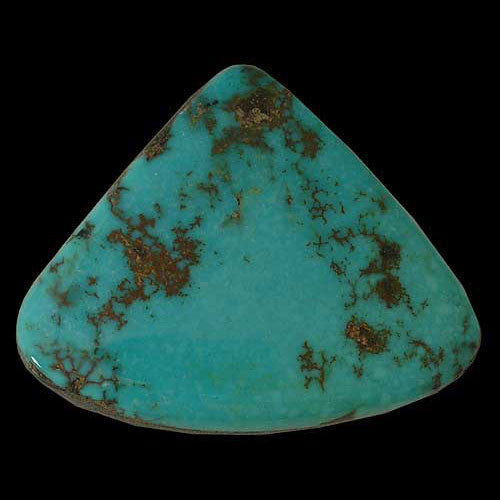
42.18 cts Natural Gem Grade Morenci Turquoise Cabochon (#6)
$845.00
Natural Morenci Turquoise
42.18 cts.
1 1/8" tall x 1 3/8" wide
We offer a 100% satisfaction guarantee on every purchase.
Morenci Turquoise; Arizona Mine, Morenci, Clifton-Morenci District, Shannon Mountains, Greenlee County, Arizona, USA. An open pit copper mine located in the N1⁄2 Section 16, T4S, R29E (Clifton 15 minute topographic map), owned by Phelps Dodge Corp. Map Reference: 33°5'26"N , 109°21'58"W.
Morenci turquoise was mined in southeastern Arizona until approximately 1990. It is located very near the New Mexico border, and ranges in color from classic high electric blue to light azure. Prehistoric Indians who valued the stone for its deep blue color were the first to discover the deposit. These people adorned themselves with rough hewn beads and carved talisman made from the mineral
Morenci is often associated with an unusual black matrix of irregular iron pyrite, which looks metallic when polished. Although they are rare, stones with unusual birds-eye patterns, red matrix and an occasional layer of silver have also been found. The Morenci name is derived from the large open pit copper mine owned and operated by the Phelps Dodge Corporation. Early examples of this striking turquoise were of the "lunch box" variety, meaning they were carried out of the mine by workers and miners.
Morenci is well known; it was one of the first types of American turquoise to find its way to the market and is always difficult to obtain because the mine was depleted so long ago. It is believed that the best Morenci ever produced was discovered in the late 1960's to early 70's. During this time period, the mine produced a high, electric blue variety with iron pyrite inclusions. Since Morenci is no longer being mined, and because of its striking color and unusual matrix combinations, high grade natural Morenci is a valuable, highly collectible mineral.
USGS; Arizona.--In Arizona turquoise ranks first in terms of value of production and is also the best known of its gem materials. Nearly all important deposits of turquoise are located near copper occurrences or in copper deposits in arid desert regions of the world. Thus, the world famous turquoise deposits associated with certain of the large Arizona copper deposits are to be expected.
Turquoise is, or has been, mined from a number of these copper mines as a byproduct, usually by outside contractors. The financial and operating terms of the collecting contracts vary from mine to mine. Some of the operations are little more than the efforts of individual commercial collectors; some are essentially full-scale mining operations that are simultaneous with, but separate from, the regular mining operations; and still others operate on an on-call basis as turquoise is uncovered by the regular copper mining operation. Regardless of the size or sophistication of the initial mining or recovery operation, the actual turquoise is recovered by careful extraction using hand methods.
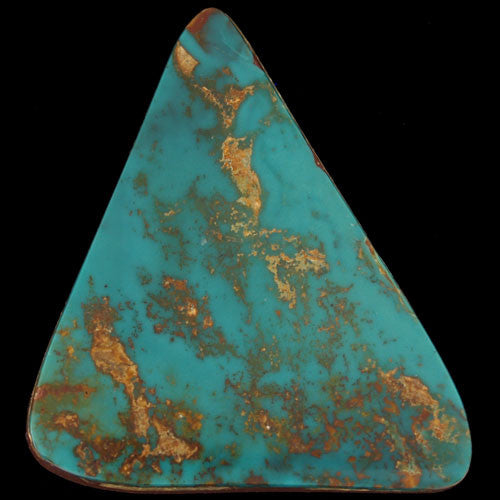
82 cts Natural Gem Grade Blue Gem Turquoise Cabochon (#20)
$3,280.00
You see before you an 82-carat cabochon of super-fine, high-grade, natural Blue Gem turquoise from Battle Mountain, Nevada, USA. This stone has so much character it seems unreal. The bright and beautiful blue/green color is simply amazing. The Blue Gem turquoise mine once produced some of the best turquoise ever unearthed. This stone was mined and cut in the mid 1970s, the heyday of Blue Gem production. Beauty, rarity and durability, this stone has all that and more.
Blue Gem Turquoise
Blue Gem turquoise occurs in argillized quartz monzonite cut by two limonite-stained sheer zones, one trending N 35 o W and dipping 75 o NE, the other trending N, 25 o E and dipping 55 o NW. An extensive breccia zone about 10 feet wide is developed between the two bounding sheers. Exceptionally good quality turquoise forms veins up to three-quarters of an inch thick along the shears. Pyrite-bearing quartz veins are closely associated with the turquoise.
The Blue Gem mine was at one time located deep underground, accessed by tunnels as deep as 800 feet. This is of interest because the Blue Gem Mine and the Bisbee Mine in Arizona are the only two mines (of which we are aware) that turquoise was found that deep in the earth. The Blue Gem mine was once developed in extensive underground workings and open stoops. An audit several hundred feet long on the main structure connected to numerous shorter tunnels and several open stoops. Directly above the main audit was a glory hole some 100 feet long.
Duke Goff first noted the Blue Gem deposit in 1934. It was subsequently leased from the Copper Canyon Mining Co. by the American Gem Co. of San Gabriel, CA., owned by Doc Wilson and his sons, Del and William. The company operated the property until 1941 when the outbreak of the war caused a shortage of experienced miners. Both Del and William Wilson were called into the Army for the duration of the war, and this compelled the closing of the mine. Consequently, the lease was allowed to lapse and work was abandoned. In 1950 Lee Hand and Alvin Layton of Battle Mountain leased the mine.
Production of turquoise at the Blue Gem lease in the early days of the operation was enormous. Although there is no exact information, it is reported that the output amounted to nearly
$1 million in rough turquoise. The mine is still active, although Duval Corp is currently in the center of a major copper deposit developing it.
Pyrite in Blue Gem is unusual to see but not unheard of. Very little large material ever came out of Blue Gem, the majority found was small 1-mm "bleeder" veins and tiny nuggets which was perfect for Zuni inlay and fine needlepoint, petit-point and snake-eyes jewelry. Blue Gem turquoise was very popular in the late 1930's and 40's and was commonly used in the Fred Harvey "tourist jewelry" that is so collectable today. Blue Gem turquoise is extremely hard and stands up well to the test of time.
Blue Gem turquoise is a rare, valuable and historic American treasure. Quality Blue Gem Turquoise has been gifted with a wide range and variety of color. Because Blue Gem turquoise is very hard, a high polish is associated with this stone, and unlike most turquoise, won't easily change color. This turquoise has a unique character and many different looks all of which are striking, full of wonder and pleasing to the eye.
Production of the mine started about 1934 and continued into the 1970's. Blue Gem Turquoise is still some of the finest turquoise ever found, and unlike most turquoise mines, (in which the majority mined is chalky and only usable if stabilized) most of the turquoise found there was of gem-quality. Today the Blue Gem mine is not viable; it sits in the middle of a huge mining operation. The emphasis is on precious metals and the extraction of turquoise is considered more of a hindrance in the mining process rather than an asset. Even the ever-popular "Dump Diving" for turquoise through the overburden is not tolerated due to the very real danger of becoming buried in a slide. Insurance factors, equipment hazards, high explosives and safety issues along with a lack of interest from the mining company keep Blue Gem turquoise unavailable to the world, at least for now.
Related legends:
Precious Stones Turquoise; Precious stones have symbolic implications. For example, turquoise if a "collective term for all the precious stones, wealth, or mixed offerings. Good fortune is attributed to this stone." Both white shell and turquoise are emphasized in Kinaalda? More about this legend
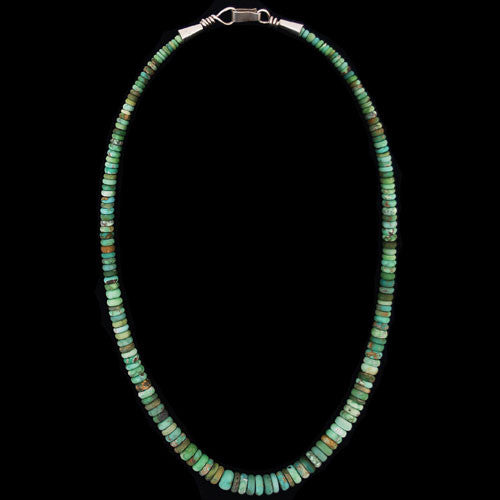
Anglo Carico Lake Turquoise Choker Necklace - Bruce Eckhardt (#19)
$3,975.00
Artist: Bruce Eckhardt
Southwest Jewelry
17 1/2" long
Bruce Eckhardt is one of the best bead makers in the Southwest. Carico Lake is one of the most distinctive types of turquoise found in the United States. Put the two together, and what do you get. An explosively beautiful choker necklace that will gather admirers anywhere you go. Wow! That is all we have to say.
We offer a 100% satisfaction guarantee on every purchase.
Carico Lake Turquoise
The Carico Lake turquoise mine is located in Lander County, Nevada, in the Carico Lake region. Carico Lake is a rather large, active mining district encompassing several claims that produce a wide variety and quality of graded blue and green turquoise; some with golden limonite matrix. Carico Lake turquoise is also found with a dark blue-green color laced with a black or brown spider web matrix. In addition to turquoise, mines in this district are known to produce faustite, a bright, Granny Smith, apple-green mineral first identified in 1953. Faustite is similar to turquoise except that it contains zinc rather than copper.
The Carico Lake mine has produced rare psuedomorph clams. These beautiful "fossilized" turquoise clams are found in the dried lakebed. The clams are believed to have been dissolved, leaving cavities that were filled with turquoise and faustite deposits.
Originally discovered in 1911, turquoise from the Carico Lake district has been marketed under several different names, including Aurora and Stone Cabin. These claims have been mined by noted Nevada prospectors such as August Stenich and later by J.W. Edgar. The mine is now owned and closely managed by Ernie Montoya. Mr. Montoya has invested heavily in Carico Lake turquoise, re-establishing the mine as one of the larger producers in Nevada. Working over 100 claims, Mr. Montoya has produced a fair amount of turquoise. High-grade turquoise is, however, still fairly uncommon. The unique range and variety of colors and scarcity of natural, gem grade Carico Lake turquoise make it a valuable addition to any collection.
About the artist:

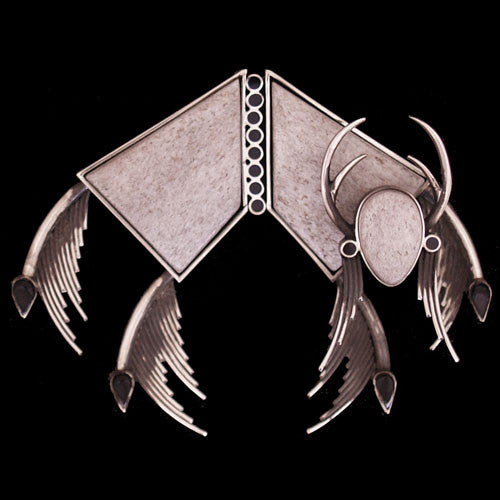
Anglo Deer Antler Shed "Young Buck Prancing" with Leather Necklace Pin/Pendant - James Olson (#299)
$625.00
Artist: James Olson
Southwest Jewelry
2 3/4" x 2"
From the fertile mind of Jamie Olson comes a pin/pendent cleverly crafted of naturally shed deer antler, Utah jet and sterling silver. Jamie has titled his broach "Young Buck Prancing". When it comes to his jewelry designs and the material he uses to produce them, this gifted artist is cleverly creative. Wearing Jamie's jewelry tells everyone you have impeccable taste.
We offer a 100% satisfaction guarantee on every purchase.
About the artist:
 James A. Olson - Jewelry/Sculpture Artist:
James A. Olson - Jewelry/Sculpture Artist:
"About my work, or lack of, it chose me as much as I chose it. Asked where I get my ideas, I can't really say for sure. I'm thankful I get them once in awhile, and have the basic skills to carry them through to a satisfactory condition, at that point and time. I'm blessed, I love what I do, it's a passion. When that love and passion is not there, I'll do something else." See full biography
Related legends:
Deer
Eating certain parts of deer will cause illness: head; nosebleed and head swelling, heart; bleeding, digestive; turn into a snake. More about this legend
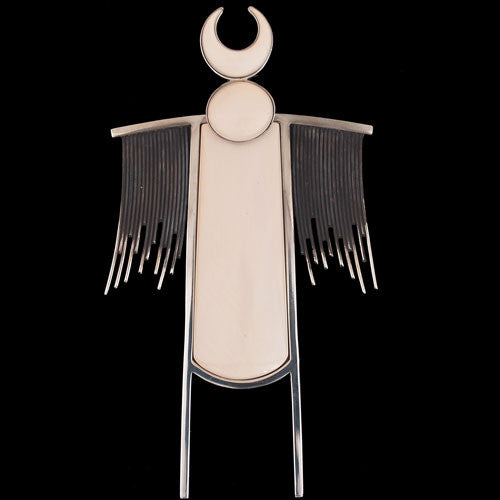
Anglo Mammoth Ivory Moon Pin/Pendant - James Olson (#327)
$625.00
Artist: James Olson
2 1/4" x 4"
Jamie Olson took a trip to Quartzite, Arizona and scoured that super-sized flea market for treasures he could use in his art. While there he discovered several beautiful pieces of ancient ivory and his creative juices began to flow. Mammoth ivory is one of Jamie's favorite materials, second only to recycled refuse that is. "Moon on head" is one of the creations spawned from that trip into the desert. I guess we should turn him loose more often.
About the artist:
 James A. Olson - Jewelry/Sculpture Artist:
James A. Olson - Jewelry/Sculpture Artist:
"About my work, or lack of, it chose me as much as I chose it. Asked where I get my ideas, I can't really say for sure. I'm thankful I get them once in awhile, and have the basic skills to carry them through to a satisfactory condition, at that point and time. I'm blessed, I love what I do, it's a passion. When that love and passion is not there, I'll do something else." See full biography
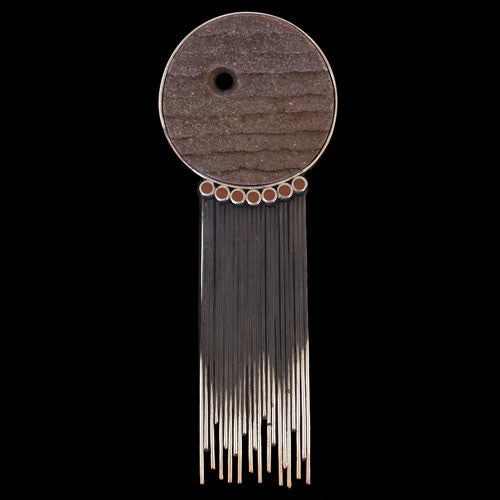
Anglo Mend Hole Corrugated Pottery Shard Pin Pendant - James Olson (#330)
$350.00
Artist: James Olson
1 1/4" x 3 1/2"
While looking through his super select pieces of pottery shards, Jamie came across this spectacular specimen with a drill hole in it. Jamie tells us the ancient ones had pots that, when broken, were not just tossed into the trash bin. In order to prolong the life of certain cracked pots, they would drill holes on opposing sides of the break and lash it back together with leather, or twine created from woven vegetation. Unfortunately this is all that remains of the cherished pottery bowl. On the other hand, it is fortunate that anything at all remains. With Jamie's help, we can look through this tiny opening, which allows our modern mind to wander back and speculate on how things might have been, oh so long ago.
About the artist:
 James A. Olson - Jewelry/Sculpture Artist:
James A. Olson - Jewelry/Sculpture Artist:
"About my work, or lack of, it chose me as much as I chose it. Asked where I get my ideas, I can't really say for sure. I'm thankful I get them once in awhile, and have the basic skills to carry them through to a satisfactory condition, at that point and time. I'm blessed, I love what I do, it's a passion. When that love and passion is not there, I'll do something else." See full biography | See all items by James A. Olson
Related legends:
Pottery
The Navajo are relatively recent arrivals to the Southwest. They probably migrated from the north in the 16th Century thereby becoming a part of the Pueblo IV period. The Navajo have made pottery since their arrival; possibly they brought pottery with them during their southern migration. They made a plain and decorated pottery. The plain being considered the older style? More about this legend

Anglo Prehistoric Pottery "Deer Standing" Pin/Pendant - James Olson (#323)
$625.00
Artist: James Olson
1 1/2" x 4 1/4"
Jamie Olson uses ancient “refuse” to make his wearable sculptures. In this piece, entitled “Deer Standing”, Jamie has utilized a piece of prehistoric pottery originally created between 1050 and 1150 A.D. The ceramics once used by ancient people for cooking and storage were found on private property and are therefore perfectly legal to own. Once utilitarian, now you can wear this pottery piece for beauty.
About the artist:
 James A. Olson - Jewelry/Sculpture Artist:
James A. Olson - Jewelry/Sculpture Artist:
"About my work, or lack of, it chose me as much as I chose it. Asked where I get my ideas, I can't really say for sure. I'm thankful I get them once in awhile, and have the basic skills to carry them through to a satisfactory condition, at that point and time. I'm blessed, I love what I do, it's a passion. When that love and passion is not there, I'll do something else." See full biography
Related legends:
Pottery
The Navajo are relatively recent arrivals to the Southwest. They probably migrated from the north in the 16th Century thereby becoming a part of the Pueblo IV period. The Navajo have made pottery since their arrival; possibly they brought pottery with them during their southern migration. They made a plain and decorated pottery. The plain being considered the older style? More about this legend
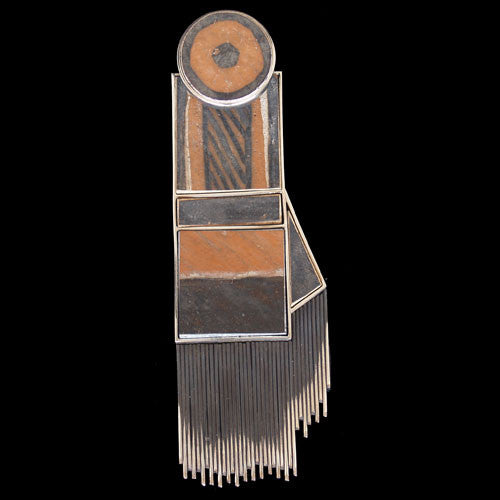
Anglo Prehistoric Pottery Shard "All Seeing Shaman" Pin/Pendant - James Olson (#325)
$565.00
Artist: James Olson
1 1/4" x 3 3/4"
Jamie Olson's "All Seeing Shaman" is one of the most creative pieces of wearable sculpture he has ever crafted. Jamie has constructed this pin/pendant from what he calls "recycled refuse", which is basically shards from prehistoric Puebloan pottery. No worries though, the pottery pieces are legally collected and documented. Jamie creates his art forms in sterling silver. This particular piece is uniquely versatile and can be worn as a pendent or a broach.
About the artist:
 James A. Olson - Jewelry/Sculpture Artist:
James A. Olson - Jewelry/Sculpture Artist:
"About my work, or lack of, it chose me as much as I chose it. Asked where I get my ideas, I can't really say for sure. I'm thankful I get them once in awhile, and have the basic skills to carry them through to a satisfactory condition, at that point and time. I'm blessed, I love what I do, it's a passion. When that love and passion is not there, I'll do something else." See full biography | See all items by James A. Olson
Related legends:
Pottery
The Navajo are relatively recent arrivals to the Southwest. They probably migrated from the north in the 16th Century thereby becoming a part of the Pueblo IV period. The Navajo have made pottery since their arrival; possibly they brought pottery with them during their southern migration. They made a plain and decorated pottery. The plain being considered the older style? More about this legend
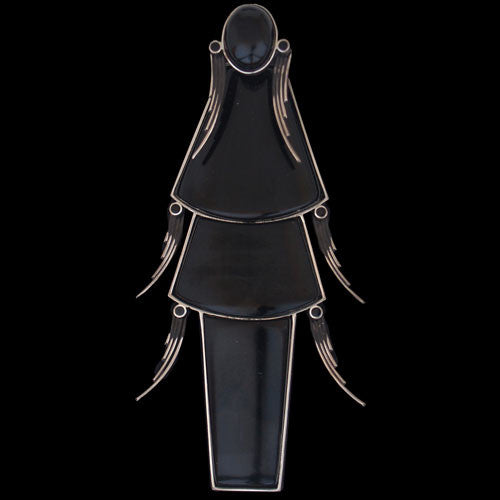
Anglo Sterling Silver and Jet "Evening Star" Pin/Pendant - James Olson (#332)
$595.00
Artist: James Olson
Southwest Jewaelry
1 3/4" x 3 3/4"
We offer a 100% satisfaction guarantee on every purchase.
About the artist:
 James A. Olson - Jewelry/Sculpture Artist:
James A. Olson - Jewelry/Sculpture Artist:
"About my work, or lack of, it chose me as much as I chose it. Asked where I get my ideas, I can't really say for sure. I'm thankful I get them once in awhile, and have the basic skills to carry them through to a satisfactory condition, at that point and time. I'm blessed, I love what I do, it's a passion. When that love and passion is not there, I'll do something else." See full biography
Canyon Cassidy/James Olson
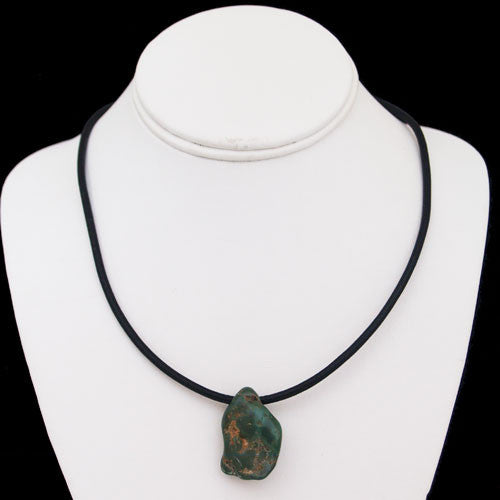
Anglo Stone Mountain Turquoise Pendant w/ Leather Necklace - Canyon Cassidy/James Olson (#316)
$345.00

Anglo Stone Mountain Turquoise Pendant w/ Leather Necklace - Canyon Cassidy/James Olson (#316)
$345.00
Artist: Canyon Cassidy/James Olson
Southwest Jewelry
Necklace: 18 1/2"
Stone: 7/8" x 1 3/8"
High-grade and natural, rough rock turquoise is what this is. This nifty nugget was derived from the Stone Mountain turquoise deposits located in high deserts of Lyon County, Nevada. Nevada Cassidy discovered the stone and made the decision to, "Keep it real", which translates into, "Just touch it up and drill a small hole." After acquiring the nugget from Nevada, we brought Jamie Olson into the equation by asking him to open the hole up a bit and make a lanyard, so someone can show it off in the best way possible. That worked-out well.
We offer a 100% satisfaction guarantee on every purchase.
Stone Mountain Turquoise
Stone Mountain Mine is located in high deserts of Lyon County, Nevada. The mine was discovered in the late 1970's. The majority of the turquoise recovered from this mine is recovered by pick and shovel.
About the artist:
 James A. Olson - Jewelry/Sculpture Artist:
James A. Olson - Jewelry/Sculpture Artist:
"About my work, or lack of, it chose me as much as I chose it. Asked where I get my ideas, I can't really say for sure. I'm thankful I get them once in awhile, and have the basic skills to carry them through to a satisfactory condition, at that point and time. I'm blessed, I love what I do, it's a passion. When that love and passion is not there, I'll do something else." See full biography | See all items by James A. Olson
Related legends:
Precious Stones
Turquoise; Precious stones have symbolic implications. For example, turquoise if a "collective term for all the precious stones, wealth, or mixed offerings. Good fortune is attributed to this stone." Both white shell and turquoise are emphasized in Kinaalda? More about this legend
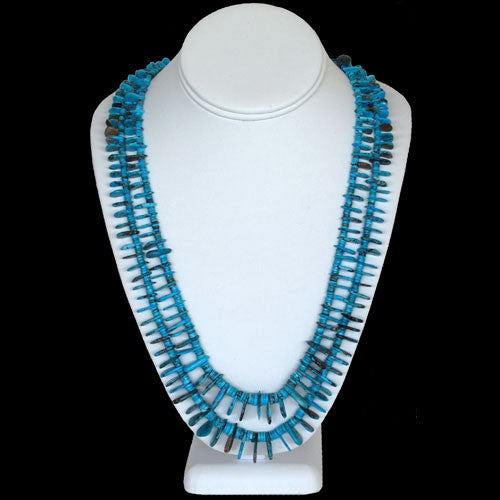
Anglo Tyrone Turquoise Tab Necklace - John Huntress (#12)
$6,000.00
Artist: John Huntress
Southwest Jewelry
31" long
Natural Gem Grade Tyron turquoise is not only exquisite; it’s exquisitely rare. This beautiful tab necklace by Anglo bead maker John Huntress is cut from stones he collected decades ago. Only recently did he bring out the collection to fashion this one-of-a-kind piece. These stones will excite your senses and convince you turquoise is one of the most memorable stones on the face of the earth, in the galaxy, throughout the universe and beyond.
Tyrone Turquoise
The Tyrone turquoise mining district is made up of a small cluster of mines in the Burro Mountains near Silver City, New Mexico. This group of mines is associated with the Tyrone Copper mine owned by Phelps-Dodge. Many turquoise historians believe that more high-grade, natural turquoise was produced in this area than any single American turquoise deposit on record. Turquoise mining in the Burro Mountains has been traced back to prehistoric times. Spanish colonists mined the workings in their own time. Mining artifacts such as stone and metal tools along with fragments of turquoise mined in this fashion were common at the sites.
An early mining engineer, named Zalenski, who visiting the mines in 1907, witnessed traces the "fire-fracture" process of extracting turquoise from the host rock. Zalenski also documented one forty-foot shaft though most of the workings. The main mining process was by way of following a vein through open trenching. Early miners and archivists mention ancient and historical Indian burial grounds in the area. The graves, most often, contained offerings of turquoise. These early excavations helped to determine the locations of some of the more modern claims. According to Pogue, John Coleman aka; "Turquois John" is credited with discovering the first modern mine in the area. While on a hunting trip in 1875, John, along with W.J. Foley and Nicholas Ransome of Silver City, are credited with discovering old excavations. The men were following up on a tip from local Indian traders. Turquoise was presumed present near the town and ancient workings were known to exist in the mountains. Their search of the Burro Mountains and surrounding area proved the rumors to be true.
The largest and most recognized mine of the Tyrone workings was the Azure. The Azure mine was initiated in 1891 and was located 10 miles southwest of Silver City. Pogue states in his 1915 classic; Turquoise, Memoirs of the National Academy of Sciences, wrote; "It has been operated in modern times more extensively than any other turquois mine in this country, and its stones are the equal of the Persian gems.” In 1893 the “Elizabeth Pocket” was discovered, which produced more high-grade turquoise than any single deposit on record. The Elizabeth Pocket was 100 feet long, 40 feet wide, and 40 to 50 feet deep. At the time it was believed to be the riches vein of turquoise ever discovered. Cabochons produced from this mine were marketed throughout the country with ads appearing in Harper and McClure’s magazines. Each gem was engraved with a circle on the back with the ad stating, "None genuine without the ring O on the reverse side.” Because of its extremely hard and durable nature Azure turquoise was guaranteed not to change color. Tyrone turquoise available on today's market is mostly from older collections. In its high-grade form Tyrone turquoise is a hard, translucent, brilliant or deep blue and is highly valued by collectors for it beauty and rarity.
About the artist:

Related legends:
Precious Stones
Turquoise; Precious stones have symbolic implications. For example, turquoise if a "collective term for all the precious stones, wealth, or mixed offerings. Good fortune is attributed to this stone." Both white shell and turquoise are emphasized in Kinaalda? More about this legend
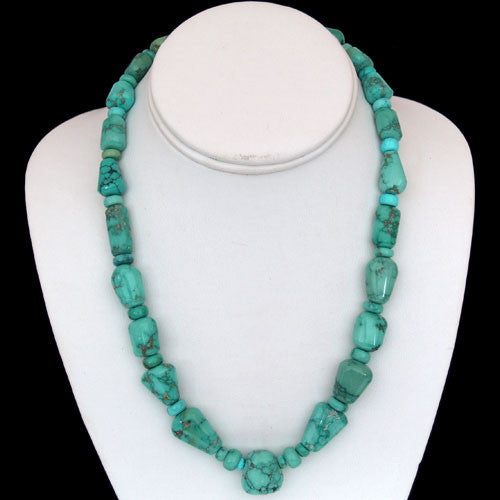
Anlgo High Grade Natural Nugget Cut Carico Lake Turquoise Necklace - Bruce Eckhardt (#21)
$2,995.00
Artist: Bruce Eckhardt
Length: 19 1/2"
Largest Nugget: .67" x .69"
Bruce Eckhardt discovered a stash of Carico Lake turquoise while traveling the back roads of central Nevada. He purchased the rough material from a retired miner, and this wonderful necklace is the end result. Bruce is one of the best bead makers in all the land, and this turquoise was extremely well suited to his skill set. This Carico Lake turquoise is hard and durable, the matrix pattern adds contrast and the pastel blue of the beads is pleasantly soothing. I'd say Bruce's discovery worked out well in all respects.
Carico Lake Turquoise
The Carico Lake turquoise mine is located in Lander County, Nevada, in the Carico Lake region. Carico Lake is a rather large, active mining district encompassing several claims that produce a wide variety and quality of graded blue and green turquoise; some with golden limonite matrix. Carico Lake turquoise is also found with a dark blue-green color laced with a black or brown spider web matrix. In addition to turquoise, mines in this district are known to produce faustite, a bright, Granny Smith, apple-green mineral first identified in 1953. Faustite is similar to turquoise except that it contains zinc rather than copper.
The Carico Lake mine has produced rare psuedomorph clams. These beautiful "fossilized" turquoise clams are found in the dried lakebed. The clams are believed to have been dissolved, leaving cavities that were filled with turquoise and faustite deposits.
Originally discovered in 1911, turquoise from the Carico Lake district has been marketed under several different names, including Aurora and Stone Cabin. These claims have been mined by noted Nevada prospectors such as August Stenich and later by J.W. Edgar. The mine is now owned and closely managed by Ernie Montoya. Mr. Montoya has invested heavily in Carico Lake turquoise, re-establishing the mine as one of the larger producers in Nevada. Working over 100 claims, Mr. Montoya has produced a fair amount of turquoise. High-grade turquoise is, however, still fairly uncommon. The unique range and variety of colors and scarcity of natural, gem grade Carico Lake turquoise make it a valuable addition to any collection.
Related legends:
Precious Stones Turquoise; Precious stones have symbolic implications. For example, turquoise if a "collective term for all the precious stones, wealth, or mixed offerings. Good fortune is attributed to this stone." Both white shell and turquoise are emphasized in Kinaalda? More about this legend
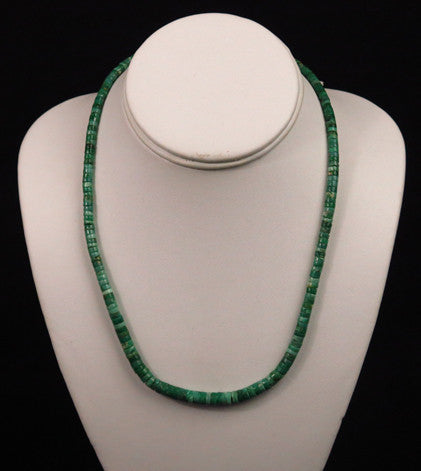
Broken Arrow Variscite Choker by Ray Lovato (#152)
$990.00
Artist: Ray Lovato
18 1/2"
Ray Lovato just drove in with a worn-out Dodge Caravan, six family members, three loaves of freshly baked Pueblo bread and a bag full of treasures. Within that saddle bag was a wonderful choker necklace of Broken Arrow Variscite. Ray said the material came from the Broken Arrow mine in Esmerelda County, Nevada. He met David Otteson, the mine owner, in Santa Fe, New Mexico and bought the rough material. Ray has the magic touch when it comes to turning raw material into a thing of beauty.
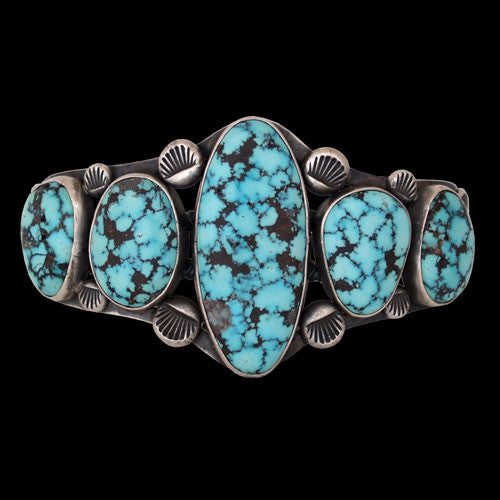
China Mountain Turquoise Bracelet - Harold Becenti (#04)
$1,225.00
Artist: Harold Becenti
Navajo Silver Jewelry
China Mountain Turquoise
set in Sterling Silver Bracelet
Size - 6 1/4
Inner Circumference - 5 1/8"
Opening - 1 1/8"
Harold Bicenti has a way with Skystone and silver. He hand fashions and crafts attractive objects of wearable art from rare and valuable elements of the Earth herself. Sterling silver and turquoise jewelry has been loved and cherished by the Navajo people since Spanish silversmiths first taught them how to set their precious turquoise into its warm embrace. Harold has found an extremely nice suite of China Mountain Turquoise and lent his considerable talent to crafting a most wonderfully traditional style wrist band.
We offer a 100% satisfaction guarantee on every purchase.
About the artist:

Harold Becenti derives from Little Water, New Mexico, a small Navajo enclave in northwestern New Mexico. He was born in 1964, but did not acquire his smithing skills until in his twenties, learning from his mother, Emma Bighand, as well as a girlfriend, Harold has developed a classic style of heavy silver jewelry featuring deep, precise stampwork and natural turquoise stones.
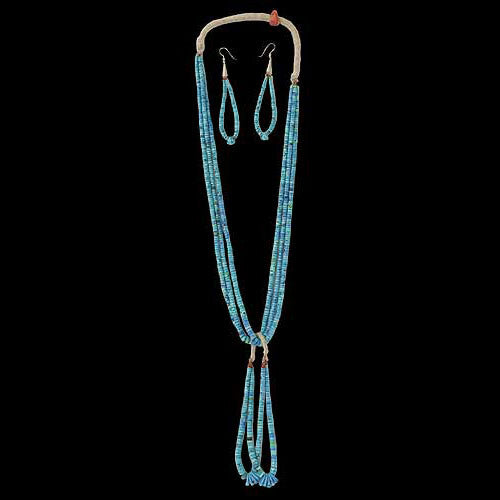
Handmade Castle Dome Turquoise Santo Domingo Necklace & Earrings set - Andrew Lovato (#01)
$6,000.00
Artist: Andrew Lovato
Santo Domingo Jewelry
Handcut and Handstrung Natural Castle Dome Turquoise
Necklace and Sterling Silver French Hook Earrings Set
Necklace - 30 1/2" long
Earrings - 3 3/8" long
We offer a 100% satisfaction guarantee on every purchase.
Jewelry sets require great investment for all parties concerned. The artist commits a significant amount of time and materials for creating a set. The best stones are selected and finding enough high quality matching stones always represents a challenge. Because the best materials are committed to the endeavor, an artist must take good care in assuring the settings are executed in an excellent manner. The very nature of producing fine sets means an artist invests the greatest time and attention in producing some of their finest work.
For the trader or gallery owner, jewelry sets represent a significant stake in that artist's final creation. It is not uncommon for a trader to provide an artist the matching stones or precious metals needed for a larger jewelry creation. With that in mind, a trusted and highly skilled artist is necessarily selected, one who will take the utmost care in the set's conception. Finally, the collector swallows hard and invests themselves in ownership of the ensuing beauty emerging from a fine jewelry artist's hands, knowing that the ownership of a beautifully executed set is its own reward.
About the artist:

Certificate of Authenticity
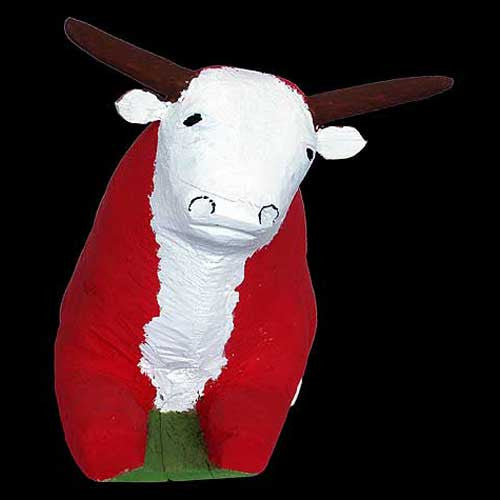
Hereford Bull Resting - Johnson Antonio (#012)
$475.00
Artist: Johnson Antonio
Navajo Folk Art
"Hereford Bull Resting"
Cottonwood/Acrylic Paint
7 3/8" tall x 10" long x 5" wide
We offer a 100% satisfaction guarantee on every purchase.
About the artist:
Johnson Antonio is a latecomer to the art world. Now in his late seventies, he was not compelled to carve until in his fifties after a long career laying steel track for the Union Pacific Railroad. Starting in 1951, they would pick him up by bus at the Tsaya Trading Post in the spring and not bring him home until the fall. In fact, while working for the railroad, Johnson met and married his wife, Lorena Henry, via a correspondence relationship.
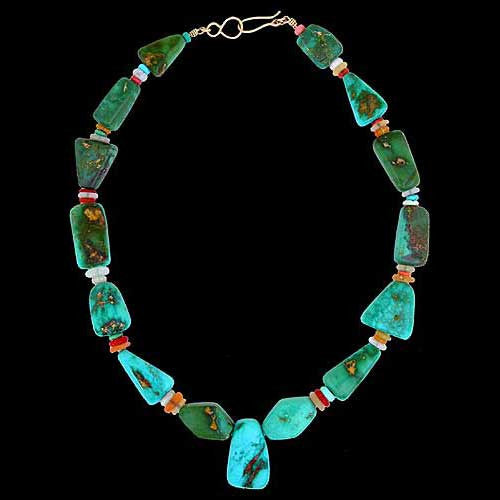
High Quality Persian Turquoise Necklace - Kai Gallagher (#05)
$3,700.00
Artist: Kai Gallagher
About the artist:

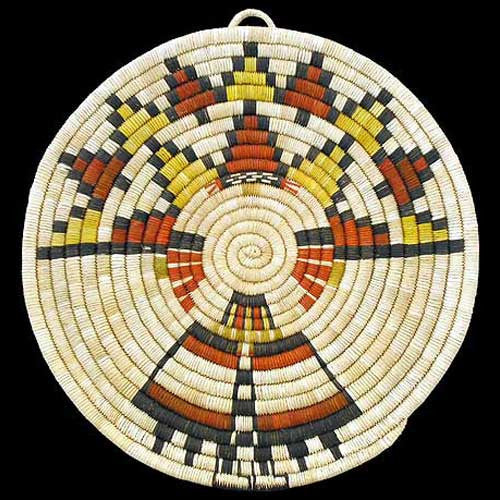
Hopi Early Morning Coil Basket (#04)
$1,250.00
12 1/2"
Hopi basket makers make some of the finest basketry in North America. Many Puebloan people no longer weave baskets, but a select few Hopi women continue this centuries-old tradition. This weaving of a Hopi Sun Face Katsina is skillfully arranged and reflects upon symbolism and tradition in Hopi design. Each Hopi basket is linked to aspects of Hopi life, past and present. In particular, basketry designs reflect aspects of Hopi religion and agriculture. For the Hopi, just as the basket's fibers are woven together, so are all the pieces of Hopi culture: none is unrelated to another.
Related legends:
Holy Ones
The meaning of the word hashch'e (Holy Ones) as employed in the names of some of the gods is not generally known. Moreover, it is not generally made public by the knowing ones who guard its meaning as a secret. Hashch'eltqii, the Talking God of the east, is the child of hayolkhal hastqin and hayolkhal esdza, to the Dawn Man and Woman? More about this legend
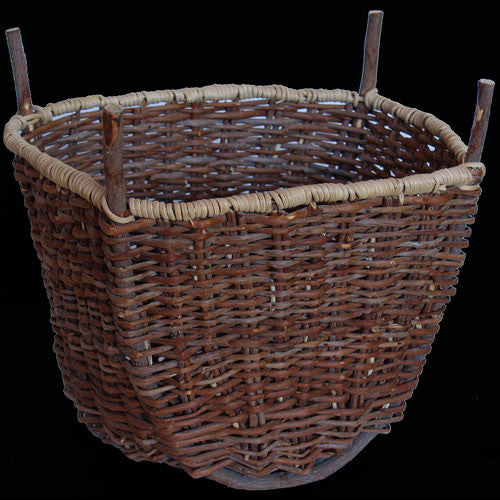
Hopi Soyok Wahti Burden Basket - Dorlene Gashweseoma (#01)
$495.00
Artist: Dorlene Gashweseoma
Basket
9" wide x 9" tall x 7" deep
Jana has been a great collector of Southwest baskets, and this Hopi Soyok Wuhti Burden Basket was one of her trade items. Many years ago as she traveled the backwoods of the Colorado Plateau she acquired this woven piece on the Hopi mesas. She is now willing to let it find a new home. May you love it as she did.
We offer a 100% satisfaction guarantee on every purchase.
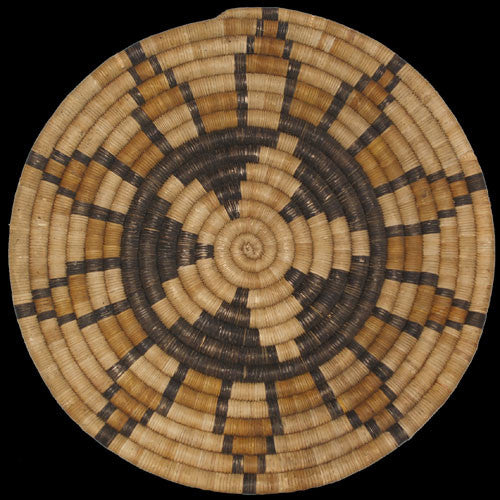
Hopi Star Design Basket Tray (#16)
$360.00
Hopi Basket
13 3/4" x 15 rounds
From the John Richardson collection, this 1960s Hopi tray has arrived at the trading post looking for a new home. Made with yucca fibre and natural dyes, it is in reasonably good condition. After about 50 years, it has accumulated a few breaks along the rim, but otherwise the old gal is in shapely.
We offer a 100% satisfaction guarantee on every purchase.
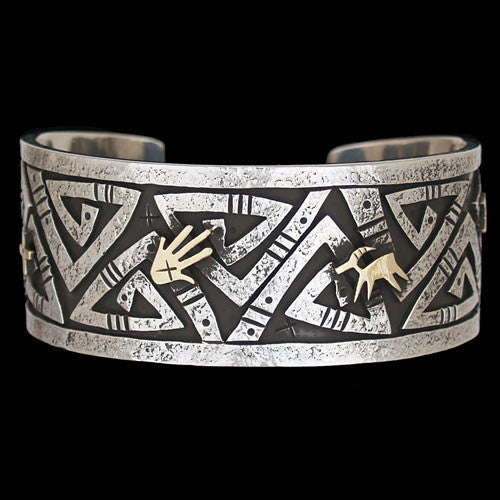
Hopi Sterling Silver and 14k Gold Eternity Symbol Bracelet - Kee Yazzie (#56)
$1,150.00
Artist: Kee Yazzie
Hopi Jewelry
Inner Circumference: 5 1/2"
Opening: 1"
Total: 6 1/2"
Width: 1 1/8"
Several layers of heavy-duty sterling silver plate make-up this artsy bracelet by Navajo artist Kee Yazzie Jr. With much hoopla about silver and gold-smithing, Kee has constructed a bracelet for the centuries. To wear this arm band out would take a highly concentrated effort indeed. With a torch, a dimpling hammer and a genius for design and creativity, Kee has placed hand, goat and duality symbols in a cuff for all to admire and appreciate. To wrap this bracelet about your wrist is to experience a cleverness of imagination and a bold depiction of ancient imagery.
We offer a 100% satisfaction guarantee on every purchase.
About the artist:

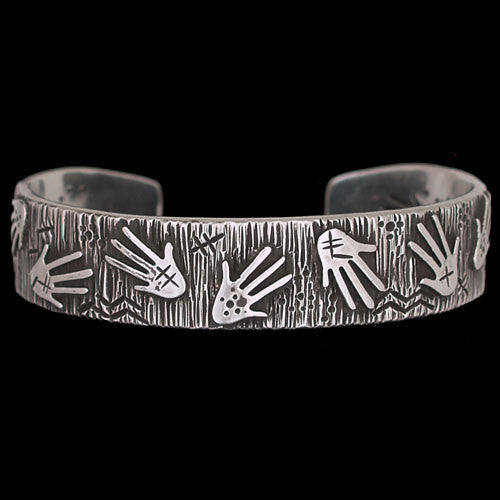
Hopi Sterling Silver Hand Symbols Bracelet - Kee Yazzie Jr. (#59)
$625.00
Artist: Kee Yazzie Jr.
Hopi Jewelry
Inner Circumference: 5 3/4"
Opening: 1"
Total: 6 3/4"
Handprints are the signatures of the ancient ones, and Kee Yazzie Jr. has taken this symbol and turned it into a meaningful and elegant bracelet. With three layers of silver and two design surfaces, Kee has put oodles and oodles of imagination into this cuff. Dragonflies, rain, eternity, male/female duality and much, much more are depicted in Kee’s work. This is a thoughtful work of art.
We offer a 100% satisfaction guarantee on every purchase.
About the artist:

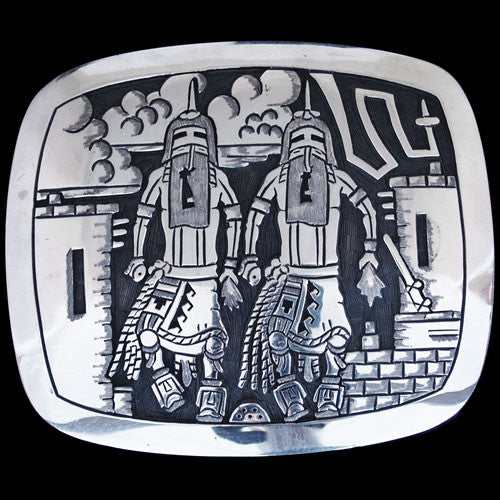
Hopi Sterling Silver Overlay Kachina Belt Buckle - Eddison Soohafyah (#02)
$850.00
Artist: Eddison Soohafyah
3" x 2 1/2"
Eddison Wadsworth Saahofyah is a Hopi artist with his home village at Shungopavi. He is a member of the corn clan. Eddison became a silversmith in 1984 and learned his craft from his father, Ted Wadsworth. His hallmark is a stylized H design, which represents the Lakota rain mark. With this buckle Eddison portrays the dance of the longhair kachina. The Angak'china is a bringer of gentle rains and flowers, his songs are melodious and his dance rhythmic and gracious. The dance occurs in the springtime and is quite popular with the Hopi people. With a steady hand, keen eye and creative style, Eddison portrays the long hair dance through the ancient streets of Shungopavi.
Related legends:
Silversmith Work
When and how the Navajo acquired the art of working metals is unknown but there are reasons for supposing that it was introduced among them, or at least more developed and improved upon by them, since the time they have occupied their present country?
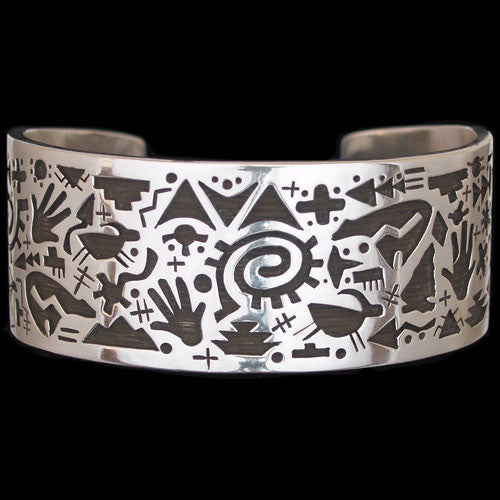
Hopi Sterling Silver Petroglyphs Bracelet - Kee Yazzie Jr. (#60)
$750.00
Artist: Kee Yazzie Jr.
Total inner circumference including opening: 6 1/2"
Opening: 1"
Width: 1"
Ancient symbols of sheep, bear, arrows, clouds, hands, eternity and rain grace this overlay bracelet by Kee Yazzie Jr. Kee’s distinctive Hopi style with sterling silversmith work is clean and contemplative, making you wonder about the old ones who left their markings on the cliffs of the Southwest. We love art that makes us think.
About the artist:

Related legends:
Silversmith Work
When and how the Navajo acquired the art of working metals is unknown but there are reasons for supposing that it was introduced among them, or at least more developed and improved upon by them, since the time they have occupied their present country?
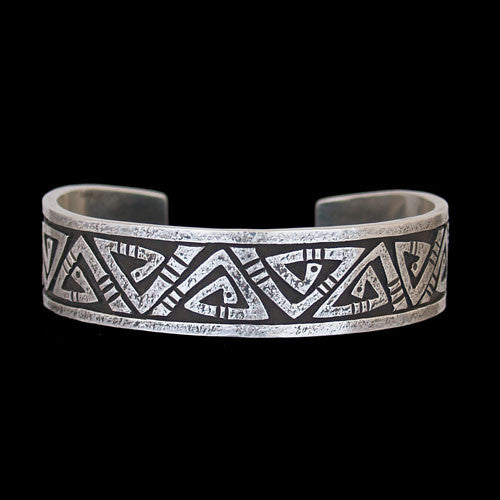
Hopi/Navajo Sterling Silver Petroglyph Design Bracelet - Kee Yazzie Jr. (#61)
$375.00
Artist: Kee Yazzie Jr.
opening: 6 1/2"
Opening: 1"
Kee Yazzie is a gatherer; he accumulates Southwestern designs of ancient and historical significance and manipulates them to fit his wearable art. The design on this bracelet came from a spiral petroglyph pattern found on local rock art and a modified snake pattern from a Hopi/Tewa pottery shard. Kee also dimpled and textured the surface for an antique appearance. Way cool.
About the artist:

Related legends:
Silversmith Work
When and how the Navajo acquired the art of working metals is unknown but there are reasons for supposing that it was introduced among them, or at least more developed and improved upon by them, since the time they have occupied their present country?
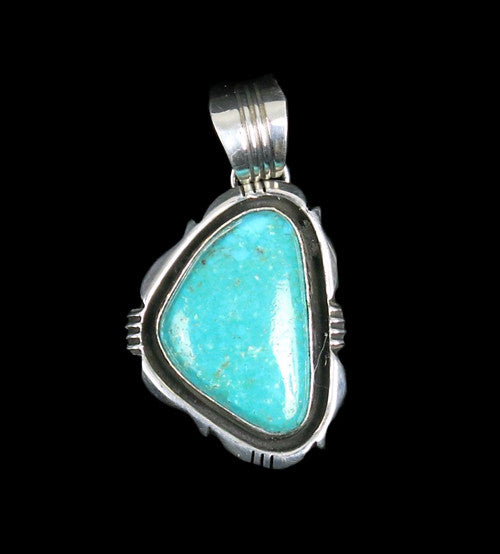
Kingman Turquoise and Sterling Silver Pendant by Will Denetdale (#280)
$265.00
Artist: Will Denetdale
Navajo silversmith Will Denetdale is one of the best and most productive artists working today. Will is in such demand because his jewelry is so clean and precise. The silver work Will wrapped around this natural high grade cabochon of Kingman, Arizona turquoise is superbly simple and elegant.
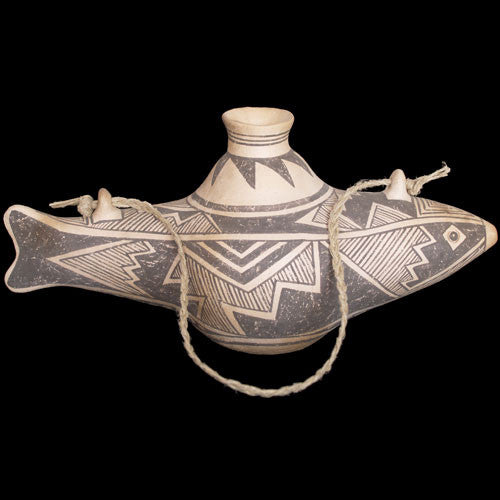
Laguna Fish Effigy Canteen Pottery - Michael Kanteena (#04)
$325.00
Artist: Michael Kanteena
Length: 10 1/4" Height: 5" Width: 4 1/4"
Michael Kanteena from Laguna pueblo specializes in contemporary pottery made with traditional designs and techniques. This particular piece came to us from a collection of interesting pieces pulled together over several years. Since we haven’t seen Michael in a while, we were happy to acquire some new work.
Related legends:
Pottery
The Navajo are relatively recent arrivals to the Southwest. They probably migrated from the north in the 16th Century thereby becoming a part of the Pueblo IV period. The Navajo have made pottery since their arrival; possibly they brought pottery with them during their southern migration. They made a plain and decorated pottery. The plain being considered the older style? More about this legend
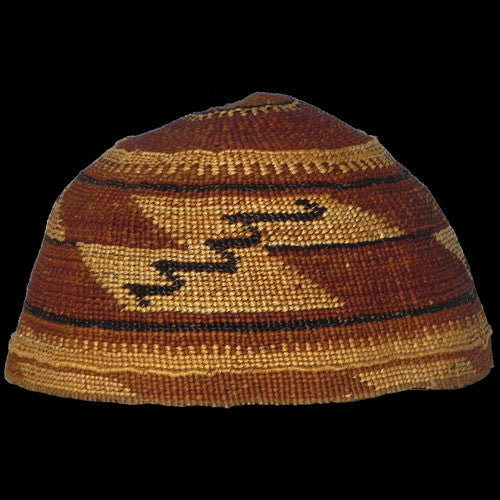
Late 1900's Karok Basketry Hat w/ Obsidian Blade Design (#03)
$1,195.00
Baskets
7" x 4"
In Northern California, Karok weavers were known for their ceremonial basket hats. This particular weaving dates from around 1900 and features an obsidian blade design. Hazel branches are used for the foundation while bear grass, maidenhair fern woodwardia are used to create the design. Steve and Georgiana Simpson collected this basket.
We offer a 100% satisfaction guarantee on every purchase.
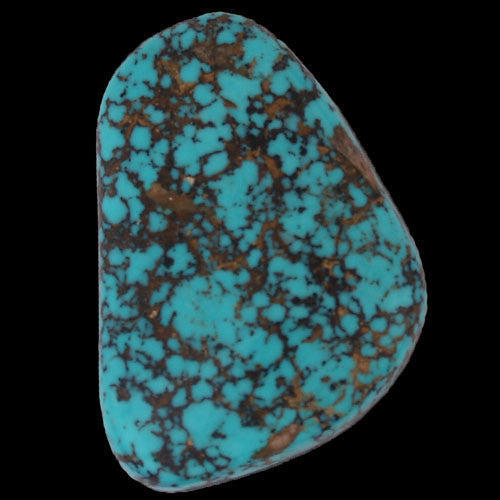
Natural 64.4cts High Grade Pilot Mountain Turquoise Cabochon (#02)
$1,610.00
Width: 1.04"
Thickness: .30"
Barry has released one of the premier gems from his private stash, which does not often happen. This Pilot Mountain cabochon was guarded for many years, but recently Barry has turned loose of it. At just over 64 carats, this is an exceptional stone.
Pilot Mountain Turquoise
The Pilot Mountain turquoise mine is also known as Montezuma or Troy Springs. The mining claim is actually made up of a group of small diggings located in Mineral County, west-central Nevada, at the southern end of the Pilot Mountains, just 14 miles east-southeast from Mina.
In 1905 William Miller of Tonopah, Nevada discovered what he called the Montezuma. The current owner, however, is headquartered in Manassa, Colorado. The property was initially claimed as a copper mine, but it was soon discovered that particular mineral was in short supply. High-grade turquoise, however, was plentiful. Copper production ceased and the area was restructured for turquoise production.
Pilot Mountain turquoise is hard, with colors ranging from a bright blue to dark blue with a greenish cast, and at times even an exceptionally dark blue. Strong deep brown limonite mottled patterns are associated with this stone. Pilot Mountain, though thinly veined, is a beautiful gem turquoise. This Nevada mine is one of the gem locations, which became famous for its extremely rare dendrites (manganese plant fossil replacements). The mine also produced some exceptionally high-grade spider web turquoise featuring interesting web matrix patterns that include red, brown and black tones. It is a hard stone, so it takes a high shine that retains color longer and is less resistant to skin oils.
Related legends:
Precious Stones Turquoise; Precious stones have symbolic implications. For example, turquoise if a "collective term for all the precious stones, wealth, or mixed offerings. Good fortune is attributed to this stone." Both white shell and turquoise are emphasized in Kinaalda? More about this legend
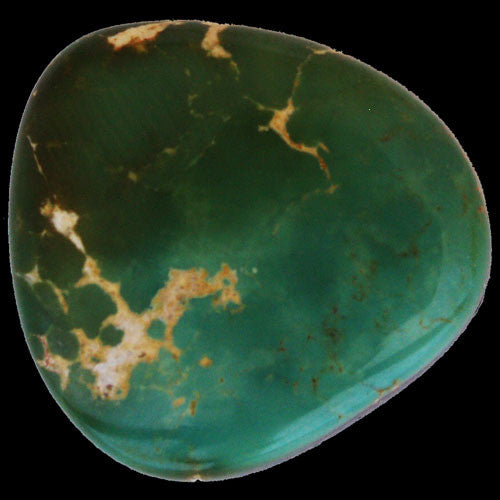
Natural Gem Grade 24cts Candaleria Turquoise Cabochon (#02)
$600.00
Natural Turquoise Cabochons
7/8" x 7/8"
Candelaria turquoise was mined in a mean and primitive area of the Candelaria Hills near Tonopah, Nevada. Much of the turquoise from the Candelaria mine was of a deep electric blue but, occasionally, a lovely green stone was brought to light. This particular stone is just such a specimen. It is super hard, which is the reason for the high shine and superior polish. For having been extracted from one of the most inhospitable places in the USA this stone is highly refined.
We offer a 100% satisfaction guarantee on every purchase.
Candaleria Turquoise
From the flanks of Mt. Diablo comes a rare an unusual find. Candaleria, Nevada was once a boomtown for silver, gold and then copper. Now it is a scrapped out ghost town sitting on the edge of a vast hole in the ground. In the 1970's a good deal of high grade, natural turquoise was pulled from that pit; sent to Manassa, Colorado to be cut and polished; then sent around the country to be set in jewelry of all types.
Related legends:
Precious Stones
Turquoise; Precious stones have symbolic implications. For example, turquoise if a "collective term for all the precious stones, wealth, or mixed offerings. Good fortune is attributed to this stone." Both white shell and turquoise are emphasized in Kinaalda? More about this legend
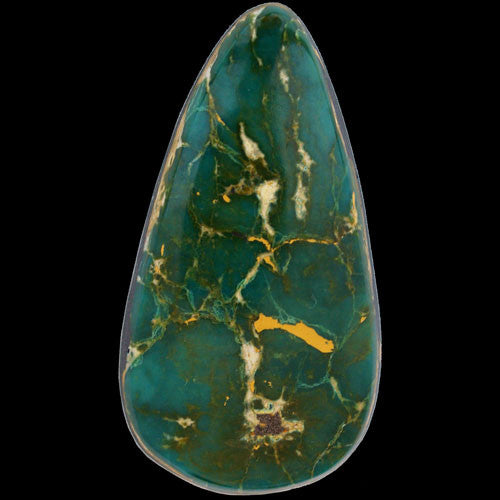
Natural Gem Grade 43.7cts Persian Turquoise Cabochon (#02)
$437.00
Natural Turquoise Cabochons
43.7 cts
1" x 1 3/4"
This crazy green turquoise with mellow yellow matrix came to us from far distant lands. Persia is well known for producing turquoise of a very high quality and this particular stone fits that designation extremely well. The stone is super hard, which is the reason behind its high shine. It is altogether natural and was cut here in the states by John Huntress of Santa Fe, NM.
We offer a 100% satisfaction guarantee on every purchase.
Persian Turquoise
In the Southwest, we tend to take turquoise for granted; yet it has been labeled the “Gemstone of the Centuries”. Over 7,500 years ago, slave convoys were sent into the Sinai Peninsula to pluck pieces of the blue gem from the rocks where it had formed. In ancient Egypt, turquoise was believed to have mystical powers and appeared in amulets and talisman representing their gods Amum and Isis. A gold and carved turquoise bracelet was found on the mummified arm of Queen Zer, a ruler during the first dynasty of Egyptian pharaohs. The four bracelets found in her burial are the earliest known examples of precious metal jewelry.
The Middle East emerged as the great purveyor of turquoise, supplying the ancient Egyptians, Nubians, Greeks and Romans. It is believed the name was derived from the French word, Turquie, a reference to the Turkish traders first bringing the rich blue stones to the European continent. It was assumed that the brilliant blue and green stones originated in Turkey when, in fact, they were most likely extracted from mines in the Sinai Peninsula and the Alimersai Mountain in Persia (Iran).
Related legends:
Precious Stones
Turquoise; Precious stones have symbolic implications. For example, turquoise if a "collective term for all the precious stones, wealth, or mixed offerings. Good fortune is attributed to this stone." Both white shell and turquoise are emphasized in Kinaalda? More about this legend
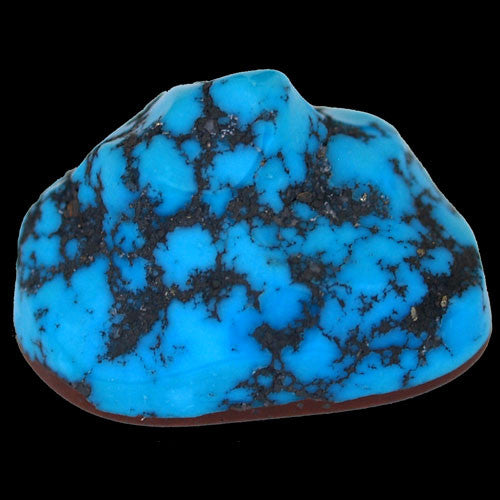
Natural Gem Grade 67 cts Castle Dome Turquoise Cabochon (#02)
$1,675.00
Natural Turquoise Cabochon
1 1/4" x 1" x 3/4"
The Castle Dome turquoise mine can be found in the Sleeping Beauty mountains of southeastern, AZ. The mine is located just over the hill from the Sleeping Beauty turquoise deposits. The property was mined-out in the early 1970's and the diggings were covered and reclaimed. Most of the turquoise produced by the mine was thin vein material and dime size nuggets. Castle Dome turquoise is, on average, of a better color and quality than its sister mine. This stone came from a batch of extra large nuggets that were discovered in the early 70's. They were cut by the DePriest family near Manassa, CO. and, promptly, put away. We purchased the stone from the family in the late 1980's. This cabochon is unusual for its size, intensity of color and wonderful black matrix. It is, definitely, the pick of the litter.
We offer a 100% satisfaction guarantee on every purchase.
Castle Dome Turquoise
Castle Dome turquoise is derived from the Globe-Miami mining district, Gila County, Arizona, five miles west of Miami. The Castle Dome open-pit copper mine, rests on the south slope of Porphyry Mountain.
Castle Dome Turquoise, CuO·3Al2O3·P2O5·H2O. --Is fairly widespread throughout the chalcocite zone and in the leached capping. A hard variety of gem quality occurs in small veinlets up to one-quarter inch thick and also in concretion-like masses up to one-half inch thick and several inches across. Its color ranges from sky-blue to bluish-green, the blue variety predominating. It is generally associated with clay minerals and sericite, which form selvages on the veins and masses and are commonly included in the turquoise. Seen under the microscope; it is a microcrystalline aggregate having a mean index of refraction of 1.62.
A few specimens of a light-green, iron-bearing copper aluminum phosphate were found occurring in the same manner as the hard blue turquoise. It is a microcrystalline aggregate whose mean index of refraction is 1.67. Charles Milton of the Geological Survey identified the mineral as a ferrian turquoise. He reports as follows:
Employees of the mine have been permitted to dig turquoise on days when they were not on duty, and dealers in Globe and Miami have purchased an amazingly large quantity of the mineral. Unfortunately no record is available as to the amount of turquoise produced, but undoubtedly the Castle Dome mine is one of the most important sources of gem turquoise at the present time.
Turquoise is generally conceded to be a supergene mineral, formed by the action of ground-water solutions, carrying copper and phosphate ions, on kaolin and possibly sericite. Various writers describe all stages in the alteration from copper-stained kaolin to hard blue turquoise; but it is not usually clear from the published descriptions whether the mineral is kaolinite or some other clay. Kaolinite is not a common mineral in the Castle Dome deposit, and its association with turquoise has not been noted; however, turquoise is commonly associated with beidellite, halloysite, and sericite. No evidence has yet been found suggesting that it forms from clay. The hard blue turquoise grades into the soft, white clay-like variety; but the index of refraction of all of it is near 1.62, which is much higher than that of any of the clays present. None of the material could be construed as being transitional between turquoise and the associated clay.
Although turquoise is most abundant in the upper part of the secondary sulfide zone, it is commonly found in deep fractures where chalcopyrite is only slightly replaced by chalcocite or not at all. If turquoise were formed by supergene solutions, the phosphate ion would have to be derived from either wavellite or apatite, which are the only earlier phosphate minerals. Wavellite is apparently dissolved by supergene solutions, but much turquoise occurs in parts of the mine where no wavellite has been recognized. In the Castle-an-Dinas mine in Cornwall, 15 wavellite spheres are commonly covered by minute botryoidal aggregates of bright-green turquoise, but no such association has been seen in the Castle Dome deposit. Most writers look to apatite as the probable source of phosphate ion even though admitting in some cases that the country rock contains very little apatite.
American Mineralogist. Volume 63, pages 574-582, PHOSPHATE MINERALS IN THE CASTLE DOME COPPER DEPOSIT, ARIZONA, N.P. Peterson, Abstract
Related legends:
Precious Stones
Turquoise; Precious stones have symbolic implications. For example, turquoise if a "collective term for all the precious stones, wealth, or mixed offerings. Good fortune is attributed to this stone." Both white shell and turquoise are emphasized in Kinaalda? More about this legend
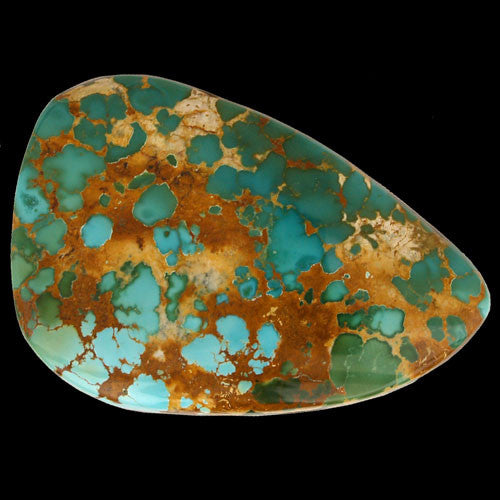
Natural Gem Grade 79.5cts Emerald Valley Turquoise Cabochon (#15)
$2,385.00
Natural Turquoise Cabochon
1 7/8" x 1 1/4"
From the Blue Gem mine south of Battle Mountain, Nevada, deep in the heart of Mother Earth, comes a stunning example of what Nature can produce under the right circumstances. This 79.5-carat gem is like none other, and there will never be another, so get it while you can.
We offer a 100% satisfaction guarantee on every purchase.
Blue Gem or Emerald Valley Turquoise
Blue Gem turquoise occurs in argillized quartz monzonite cut by two limonite-stained sheer zones, one trending N 35 o W and dipping 75 o NE, the other trending N, 25 o E and dipping 55 o NW. An extensive breccia zone about 10 feet wide is developed between the two bounding sheers. Exceptionally good quality turquoise forms veins up to three-quarters of an inch thick along the shears. Pyrite-bearing quartz veins are closely associated with the turquoise.
The Blue Gem mine was at one time located deep underground, accessed by tunnels as deep as 800 feet. This is of interest because the Blue Gem Mine and the Bisbee Mine in Arizona are the only two mines (of which we are aware) that turquoise was found that deep in the earth. The Blue Gem mine was once developed in extensive underground workings and open stoops. An audit several hundred feet long on the main structure connected to numerous shorter tunnels and several open stoops. Directly above the main audit was a glory hole some 100 feet long.
Duke Goff first noted the Blue Gem deposit in 1934. It was subsequently leased from the Copper Canyon Mining Co. by the American Gem Co. of San Gabriel, CA., owned by Doc Wilson and his sons, Del and William. The company operated the property until 1941 when the outbreak of the war caused a shortage of experienced miners. Both Del and William Wilson were called into the Army for the duration of the war, and this compelled the closing of the mine. Consequently, the lease was allowed to lapse and work was abandoned. In 1950 Lee Hand and Alvin Layton of Battle Mountain leased the mine.
Production of turquoise at the Blue Gem lease in the early days of the operation was enormous. Although there is no exact information, it is reported that the output amounted to nearly
$1 million in rough turquoise. The mine is still active, although Duval Corp is currently in the center of a major copper deposit developing it.
Pyrite in Blue Gem is unusual to see but not unheard of. Very little large material ever came out of Blue Gem, the majority found was small 1-mm "bleeder" veins and tiny nuggets which was perfect for Zuni inlay and fine needlepoint, petit-point and snake-eyes jewelry. Blue Gem turquoise was very popular in the late 1930's and 40's and was commonly used in the Fred Harvey "tourist jewelry" that is so collectable today. Blue Gem turquoise is extremely hard and stands up well to the test of time.
Blue Gem turquoise is a rare, valuable and historic American treasure. Quality Blue Gem Turquoise has been gifted with a wide range and variety of color. Because Blue Gem turquoise is very hard, a high polish is associated with this stone, and unlike most turquoise, won't easily change color. This turquoise has a unique character and many different looks all of which are striking, full of wonder and pleasing to the eye.
Production of the mine started about 1934 and continued into the 1970's. Blue Gem Turquoise is still some of the finest turquoise ever found, and unlike most turquoise mines, (in which the majority mined is chalky and only usable if stabilized) most of the turquoise found there was of gem-quality. Today the Blue Gem mine is not viable; it sits in the middle of a huge mining operation. The emphasis is on precious metals and the extraction of turquoise is considered more of a hindrance in the mining process rather than an asset. Even the ever-popular "Dump Diving" for turquoise through the overburden is not tolerated due to the very real danger of becoming buried in a slide. Insurance factors, equipment hazards, high explosives and safety issues along with a lack of interest from the mining company keep Blue Gem turquoise unavailable to the world, at least for now.
Related legends:
Precious Stones
Turquoise; Precious stones have symbolic implications. For example, turquoise if a "collective term for all the precious stones, wealth, or mixed offerings. Good fortune is attributed to this stone." Both white shell and turquoise are emphasized in Kinaalda? More about this legend
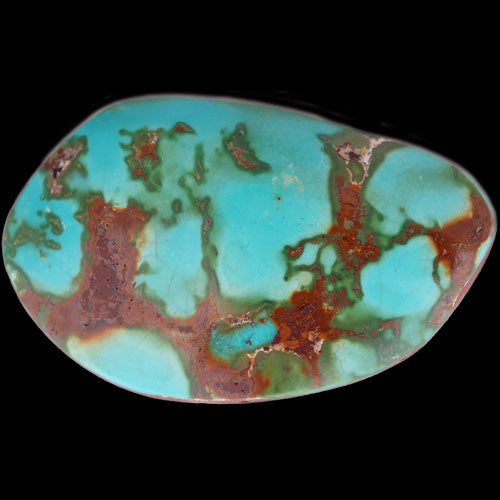
Natural Gem Grade 83cts Blue Gem Turquoise Cabochon (#02)
$2,075.00
Natural Turquoise Cabochon
2" x 1 1/4"
Barry has finally turned loose of one of the great stones he has sequestered over the years. From a collection he acquired almost 20 years ago, Barry has protected this large piece of Blue Gem turquoise for about two decades. Get it now before he realizes just what he is giving up.
We offer a 100% satisfaction guarantee on every purchase.
Blue Gem Turquoise Cabochon
Blue Gem turquoise occurs in argillized quartz monzonite cut by two limonite-stained sheer zones, one trending N 35 o W and dipping 75 o NE, the other trending N, 25 o E and dipping 55 o NW. An extensive breccia zone about 10 feet wide is developed between the two bounding sheers. Exceptionally good quality turquoise forms veins up to three-quarters of an inch thick along the shears. Pyrite-bearing quartz veins are closely associated with the turquoise.
The Blue Gem mine was at one time located deep underground, accessed by tunnels as deep as 800 feet. This is of interest because the Blue Gem Mine and the Bisbee Mine in Arizona are the only two mines (of which we are aware) that turquoise was found that deep in the earth. The Blue Gem mine was once developed in extensive underground workings and open stoops. An audit several hundred feet long on the main structure connected to numerous shorter tunnels and several open stoops. Directly above the main audit was a glory hole some 100 feet long.
Duke Goff first noted the Blue Gem deposit in 1934. It was subsequently leased from the Copper Canyon Mining Co. by the American Gem Co. of San Gabriel, CA., owned by Doc Wilson and his sons, Del and William. The company operated the property until 1941 when the outbreak of the war caused a shortage of experienced miners. Both Del and William Wilson were called into the Army for the duration of the war, and this compelled the closing of the mine. Consequently, the lease was allowed to lapse and work was abandoned. In 1950 Lee Hand and Alvin Layton of Battle Mountain leased the mine.
Production of turquoise at the Blue Gem lease in the early days of the operation was enormous. Although there is no exact information, it is reported that the output amounted to nearly
$1 million in rough turquoise. The mine is still active, although Duval Corp is currently in the center of a major copper deposit developing it.
Pyrite in Blue Gem is unusual to see but not unheard of. Very little large material ever came out of Blue Gem, the majority found was small 1-mm "bleeder" veins and tiny nuggets which was perfect for Zuni inlay and fine needlepoint, petit-point and snake-eyes jewelry. Blue Gem turquoise was very popular in the late 1930's and 40's and was commonly used in the Fred Harvey "tourist jewelry" that is so collectable today. Blue Gem turquoise is extremely hard and stands up well to the test of time.
Blue Gem turquoise is a rare, valuable and historic American treasure. Quality Blue Gem Turquoise has been gifted with a wide range and variety of color. Because Blue Gem turquoise is very hard, a high polish is associated with this stone, and unlike most turquoise, won't easily change color. This turquoise has a unique character and many different looks all of which are striking, full of wonder and pleasing to the eye.
Production of the mine started about 1934 and continued into the 1970's. Blue Gem Turquoise is still some of the finest turquoise ever found, and unlike most turquoise mines, (in which the majority mined is chalky and only usable if stabilized) most of the turquoise found there was of gem-quality. Today the Blue Gem mine is not viable; it sits in the middle of a huge mining operation. The emphasis is on precious metals and the extraction of turquoise is considered more of a hindrance in the mining process rather than an asset. Even the ever-popular "Dump Diving" for turquoise through the overburden is not tolerated due to the very real danger of becoming buried in a slide. Insurance factors, equipment hazards, high explosives and safety issues along with a lack of interest from the mining company keep Blue Gem turquoise unavailable to the world, at least for now.
Related legends:
Precious Stones
Turquoise; Precious stones have symbolic implications. For example, turquoise if a "collective term for all the precious stones, wealth, or mixed offerings. Good fortune is attributed to this stone." Both white shell and turquoise are emphasized in Kinaalda? More about this legend
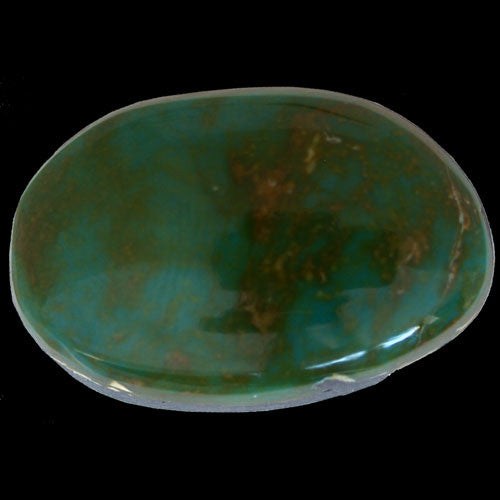
Natural Gem Grade Persian 28.3cts Turquoise Cabochon (#03)
$339.00
Natural Turquoise Cabochons
1 1/8" x 3/4"
This cabochon of Armenian "Persian" turquoise came to us through John Huntress and Bruce Eckhardt. It came to them through an Armenian citizen looking to pedal turquoise in New Mexico. Glad they took the bait. This is a fabulous stone of some of the hardest and well-formed material we have seen. It surely came from an outstanding cache of turquoise.
We offer a 100% satisfaction guarantee on every purchase.
Persian Turquoise
In the Southwest, we tend to take turquoise for granted; yet it has been labeled the “Gemstone of the Centuries”. Over 7,500 years ago, slave convoys were sent into the Sinai Peninsula to pluck pieces of the blue gem from the rocks where it had formed. In ancient Egypt, turquoise was believed to have mystical powers and appeared in amulets and talisman representing their gods Amum and Isis. A gold and carved turquoise bracelet was found on the mummified arm of Queen Zer, a ruler during the first dynasty of Egyptian pharaohs. The four bracelets found in her burial are the earliest known examples of precious metal jewelry.
The Middle East emerged as the great purveyor of turquoise, supplying the ancient Egyptians, Nubians, Greeks and Romans. It is believed the name was derived from the French word, Turquie, a reference to the Turkish traders first bringing the rich blue stones to the European continent. It was assumed that the brilliant blue and green stones originated in Turkey when, in fact, they were most likely extracted from mines in the Sinai Peninsula and the Alimersai Mountain in Persia (Iran).
Related legends:
Precious Stones
Turquoise; Precious stones have symbolic implications. For example, turquoise if a "collective term for all the precious stones, wealth, or mixed offerings. Good fortune is attributed to this stone." Both white shell and turquoise are emphasized in Kinaalda? More about this legend
Leonard & Emily Tsosie
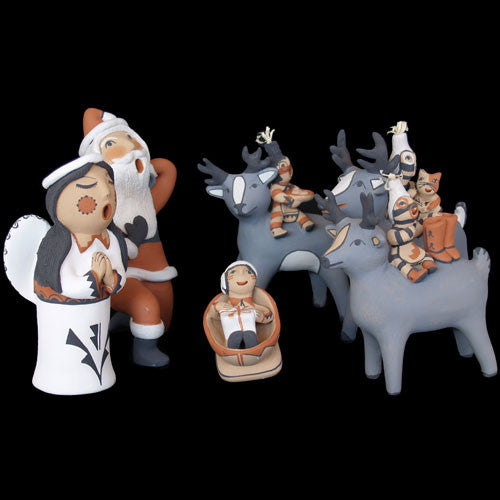
Navajo & Jemez "Santa's First Delivery" Pottery Set - Leonard & Emily Tsosie (#01)
$925.00

Navajo & Jemez "Santa's First Delivery" Pottery Set - Leonard & Emily Tsosie (#01)
$925.00
Artist: Leonard & Emily Tsosie
Folk Art
Tallest Piece: 8"
Shortest Piece: 3"
This nativity set is for in-store pick-up only. This whimsical portrayal of the holy nativity is completely hand-formed and crafted by Navajo/Jemez couple Leonard and Emily Tsosie. Reindeer have been replaced by mule deer and the Holy Men by the koshare. An angel prays and Santa sings over a gifted child. This is a wonderful set for those collectors in search of a new and creative interpretation of a well loved and often told story.
We offer a 100% satisfaction guarantee on every purchase.
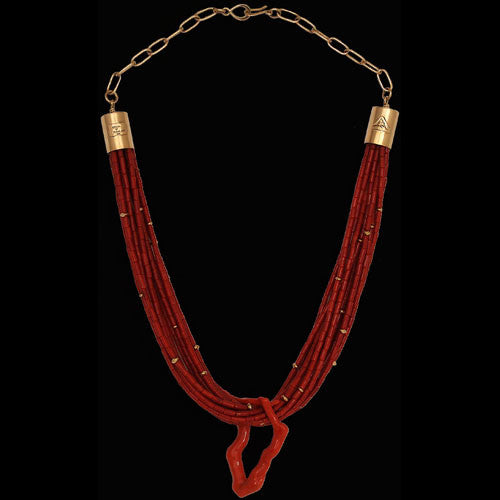
Navajo 13 Strand Coral & 14k Gold Necklace - Alfred Lee (#01)
$8,500.00
Artist: Alfred Lee
Navajo Jewelry
29" long
Navajo artist Alfred Lee has created an extraordinary necklace of Mediterranean coral and 14k gold. Alfred met an Italian family with ties to the old world while attending a jewelry show in Pasadena, California. The family just happened to have some of the best branch coral Alfred had ever seen, so he traded jewelry for it. Upon his return to New Mexico, Alfred began cutting and drilling the coral to make beads, matching pendent and accompanying gold work. This necklace is the result of that trade and creative process. Superb!
We offer a 100% satisfaction guarantee on every purchase.
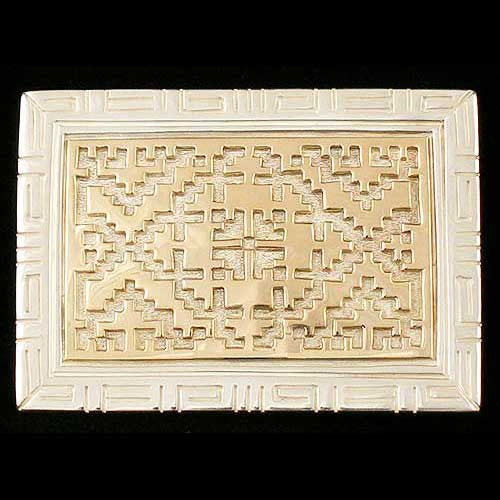
Navajo 14K Gold & Silver Buckle - Ro1bert Taylor (#05)
$1,625.00
Artist: Ro1bert Taylor
Navajo Jewelry
14k Gold & Sterling Silver Buckle
2 7/16" wide x 1 11/16" tall
We offer a 100% satisfaction guarantee on every purchase
About the artist:

Robert Taylor - Silver & Goldsmith:
"Cluster, channel, leaf, inlay, casting... I've done about everything," Robert Taylor talks about his silver and goldsmithing, "There's a lot of artists that do it." And then he confides the reason he has set himself apart from other craftsmen. "I didn't really get anywhere until I decided to design my own style."
Related legends:
Silversmith Work
When and how the Navajo acquired the art of working metals is unknown but there are reasons for supposing that it was introduced among them, or at least more developed and improved upon by them, since the time they have occupied their present country?
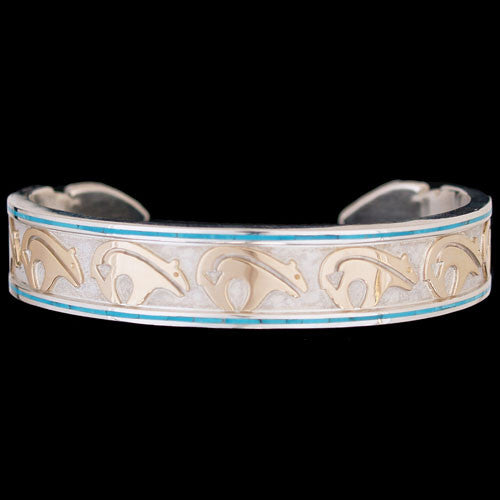
Navajo 14k Gold and Turquoise Bear Fetish Bracelet - Robert Taylor (#43)
$2,750.00
Artist: Robert Taylor
Navajo Jewelry
Inner Circumference: 5 3/4"
Opening: 1"
Total: 6 3/4"
Navajo silversmith Robert Taylor wanted to share a bit of safety and stability with this wrist cuff. Bears are a gift of Changing Woman to guard the people, and arrowheads are a gift of Grandfather Horned Toad to protect against great danger. Robert wrapped his golden bear in shrouds of blue sky, to show that higher powers are involved. Robert Taylor is a master silversmith; his designs are graceful and dramatic at the same time and his finish detail is amazing.
We offer a 100% satisfaction guarantee on every purchase.
About the artist:

Robert Taylor - Silver & Goldsmith:
"Cluster, channel, leaf, inlay, casting... I've done about everything," Robert Taylor talks about his silver and goldsmithing, "There's a lot of artists that do it." And then he confides the reason he has set himself apart from other craftsmen. "I didn't really get anywhere until I decided to design my own style."
Related legends:
Protection/Practice
Ambush, a shelter formed by two trees or shrubs whose branches intermingle, is a setting repeatedly occurring in myth, giving the explanation for various ritualistic properties-emetic frames, hoops, pokers, prayersticks, wood samples. A hero, hoping to shoot a mountain sheep or other animal he did not recognize as a god, lay behind the 'ambush trees,' but when the animal appeared, was numb until it had passed. The animal deity, revealing himself, taught the hero ceremonial lore? More about this legend
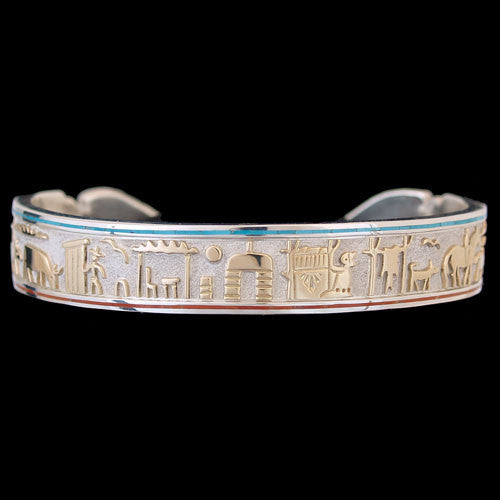
Navajo 14k Gold, Turquoise, and Coral Protection Brecelet - Robert Taylor (#42)
$2,750.00
Artist: Robert Taylor
Navajo Jewelry
Inner Circumference: 6 1/4"
Opening: 1 1/8"
Total: 7 3/8"
Turquoise and coral, silver and gold, land and sky, shepherd and livestock; these are combinations as old as Navajo culture itself. Robert Taylor combines all these elements to make one extraordinary man’s bracelet. Robert’s sense of humor is as well developed as his silversmithing skills, so you get a humorous commentary on Navajo lifestyle in a cuff you will treasure the rest of your life, and maybe into the afterlife.
We offer a 100% satisfaction guarantee on every purchase.
About the artist:

Robert Taylor - Silver & Goldsmith:
"Cluster, channel, leaf, inlay, casting... I've done about everything," Robert Taylor talks about his silver and goldsmithing, "There's a lot of artists that do it." And then he confides the reason he has set himself apart from other craftsmen. "I didn't really get anywhere until I decided to design my own style."
Related legends:
Protection/Practice
Ambush, a shelter formed by two trees or shrubs whose branches intermingle, is a setting repeatedly occurring in myth, giving the explanation for various ritualistic properties-emetic frames, hoops, pokers, prayersticks, wood samples. A hero, hoping to shoot a mountain sheep or other animal he did not recognize as a god, lay behind the 'ambush trees,' but when the animal appeared, was numb until it had passed. The animal deity, revealing himself, taught the hero ceremonial lore? More about this legend
